A guide to bass fishing from the shore and boat. Looking at how to fish different shore marks for bass as well as fishing from the boat and trolling.
Bass is a distinctive fish having two dorsal fins, the front carrying 8 to 9 sharp spines, and the body is covered in big scales. The colouration tends to be green-grey on the back, occasionally dark blue, shading to silver sides and a white belly. Some bass can also sport a dark spot on the gill cover. Only the black bream looks remotely like the bass, but the bream is far more oval, whereas the bass is a long round-bodied fish.
Bass range as far south as the Mediterranean and the North African coast, but also north to southern Norway. They are common throughout the southern half of the UK, over the past two decades they have extended their range along the east and west coasts of Scotland and are now caught in growing numbers as far north as Dunnet and occasionally from the beaches in the Orkney Islands. Bass are also commonly found along the southeast, southern and southwestern coasts of Ireland, and to a lesser extent along the north coast of Northern Ireland, though again their numbers have shown an increase, especially in Donegal.
Bass, referred to by the French as "Loup de Mer" meaning the Wolf of the Sea due to their prowess as a hunter, have a wide-ranging diet taking crabs, shellfish, shrimps, sandeels, worms. Bass will also feed on a wide variety of fish such as mackerel, gobies, blennies, pouting, poor cod, rockling, sprat, squid. Bass will often scavenge human food waste inside harbours such as bacon and chicken bones that have been thrown over the side of boats.
Their breeding season is from late February through to late May. This occurs mainly in deeper water offshore between January and March. However, some knowledgeable bass anglers have witnessed large adult bass behaving in a breeding manner in shallow water at the heads of estuaries in the mid May period. This indicates we may not know all we think we do when it comes to bass breeding habits.
Bass can be caught throughout the year south of a line drawn roughly between Cumbria and North Yorkshire, but in the far north of Scotland, the season tends to be late June through to late October, generally speaking. In southern Ireland, bass again can be caught all year round, especially in Wexford, Cork and Kerry, but in the north, the season is shortened to mid-June through to late October.
However, due to changing seasonal weather patterns around the UK, resulting in milder winters generally, bass can sometimes stay inshore and feeding right through to Christmas. This also seems to be when there is a definite increase in the chances of a bigger 10lb plus fish being caught. This though has always been the case in the west of Ireland, where traditionally, some of the best bass fishing was either side of Christmas, especially on the Kerry beaches. Though the overall numbers were down, the average size of fish was bigger.
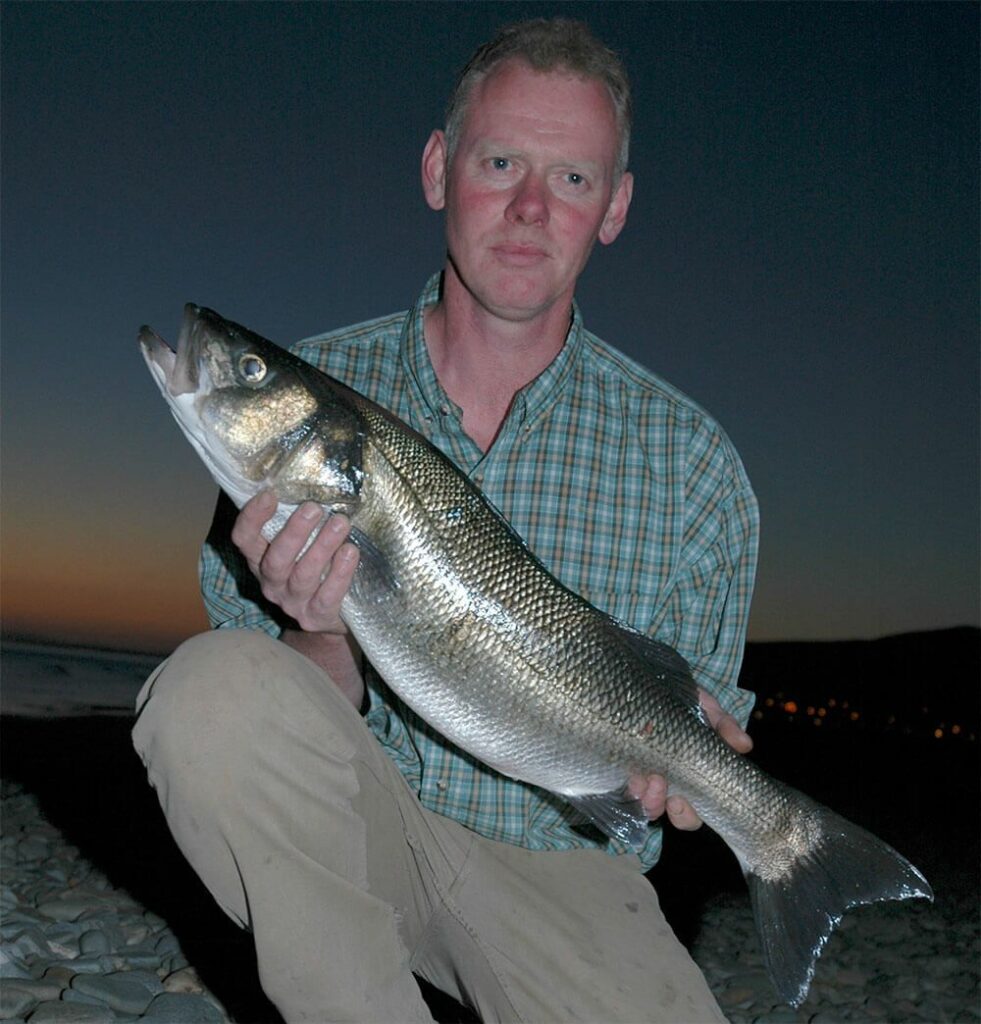
Tides are vitally important! Bass tend to work a surf beach from low water and for the first two hours of the new flood, then typically disappear for the middle hours of the flood but return for the final hour before high water and sometimes stay for the first hour of the ebb. This is a general rule, not always fact, with some beaches being devoid of bass on the flood but fishing well on the ebb. This scenario often occurs when an estuary flanks the beach. Bass run the estuary on the flood tide, but as they leave the estuary as the tide begins to flow out, they drop back down the length of the beach with the ebbing tide.
Shallow Surf Beaches
The best of the surf bass beaches tend to be shallow, often cut with parallel deeper gutters, and will fully or partially face the prevailing winds. Ideal surf conditions, typically produced by steady force two to force five onshore winds, tend to be when the surf tables are wide, not when the surf is short and breaking close together. That said, huge surfs generated by a series of strong onshore winds can still produce fish. Bass is a powerful fish and can cope with what looks to the angler like impossible seas. Those that persevere through these tough conditions can sometimes be rewarded by good catches providing they have the casting ability to reach the deeper water.
In a good surf and coloured water, bass can be caught in daylight, but generally, the best of the fishing will be in the hours of darkness. If possible, try to choose tides that begin to flood fully in the dark. Such conditions induce the highest numbers of fish inshore. Tides that flood in daylight can see reduced numbers of fish, especially if the water is clear. Peak times for feeding are when low water coincides with dusk or dawn.
If you have no choice but to fish a daylight tide, then the best conditions are when there is good cloud cover to subdue the light levels entering the shallow water. Bright sunshine on surf beaches is rarely good. If the day is bright, then try to seek out deeper water where the light levels are less intrusive!
Fish holding feature is the key to finding the fish on surf beaches. Feature will be deeper gutters that typically run parallel or at angles along the length of the beach. These are created by tidal current and by the turning over of the waves where they meet shallow banks and cause a backflow as the previous wave recedes. These gutters can be formed from clean sand, but some may have small stones or pebbles in the bottom. As the waves push forward, any displaced food items get washed into the gutters and stay there. Bass know this and will run these gutters with the flood tide but facing directly into the tide so they can pick up the waterborne scent from any food items. Also good are obvious depressions in the sand where the tide has scoured out shallow holes. Again, food gets deposited here, and these can often be seen by looking for areas where water holds after the tide has dropped back. Many people think bass hunt swimming with the tide, but the reality is the opposite. Bass usually swim into the tide, often pausing to maintain station and "sniff" the water for food scent, sometimes dropping backwards short distances while still facing the current.
Other surf beach features to look out for are areas of small stone or boulders. These again catch and hold food, as well as offer shelter to small fish crabs and other crustaceans. These areas will always see bass quarter them thoroughly at the appropriate stage of the tide. Areas of small weed growth will also draw fish, as will areas where there are a series of scoured out holes in the sand. The latter is where sandeels often bury in the sand, and the bass will hunt these here. Single big boulders are another spot where a bait is more likely to be taken. Even small almost inconsequential things like old wooden stakes buried upright in the sand that nets may have been staked to will pull bass as they see scoured out areas around their base that crabs and shrimp will hide in.
Something else to take note of is the high tide line, especially on beaches backed by shingle banks. If you look closely, you'll identify areas where there is far more waterborne debris such as wood and plastic washed up than in other areas. This indicates where a tidal-current washes inshore and on the shingle bank and bass will use these flows of current to search for food out in the deeper water.
There's an old saying that the bass are behind the third breaker, but this generally is not always true. One reason for this is that that is often as far as the average angler can cast so most of the fish will come from that distance. Bass though can literally be at your feet or 150-yards plus out. Typically, though, in ideal surf conditions and depending on depth, the bass will be from 20-yards to 80-yards out, but often working a precise band of water a set distance offshore. This will change as water depth deepens and shallows as the tide floods in. Therefore very successful bass anglers do not cast a set distance every time. If your first two casts to say 80yds do not produce, then start dropping each subsequent cast 10yds less each time until you find the fish. If this doesn't work, then cast as far as you possibly can. Wading as far as is sensible and then casting as far as possible, can often be the tactic that finds a fish on a day when few fish are feeding.
In really rough seas big bass may again be very close in amongst the breakers if the water is a good 5 to 6-feet of constant depth but are more likely to be 100-yards or more out in deeper water on shallower surf beaches where the undertow from the surf pulls food back out as it's disturbed from the sand.
Steep-to Beaches
A steep-to beach is one where the water is much deeper with a high rising shingle bank at the high-water level. The shingle will usually extend below the average low water line, too.
These will fish better in daylight than shallower water, but their wave configuration will typically be one or two breaking waves only. Food gets washed in from further out and then gets lodged at the base of the hidden low water shingle. This is the place to target bass which will run the junction of shingle and sand. This may only require a short cast between 40 and 60-yards but can be highly effective.
On these deeper beaches, often the ground is relatively clean, but there will be areas further out where fish may collect. These will typically be areas of sandbanks or again deeper gutters that form where tidal currents run. If you stand on the shingle and look at the surface water, note any area where there is confused or troubled water where small waves break. This indicates areas on the seabed that are different than the flowing tides passes over, creating a surface disturbance. Remember these will show on the surface downtide of where their actual seabed position is depending on how fast the tide flow is. You need to walk uptide maybe 50 to 100yds until you find the actual seabed feature.
Steep-to beaches can also fish very well for bass immediately after a storm when the sea remains rough, but the wind has dropped. This is when all the washed-out shellfish such as queen cockle, mussel, also lugworms, get washed into that low water line.
An ideal shallow surf bass rod would be rated 2 to 4oz and be between 11ft 6ins and 11ft 9ins in length. This is an ideal length and light enough to hold for long periods when feeling for bites. The action needs to be a semi supple tip, but with quickening power in the upper mid-section to give good casting range with light leads, but also to drive hooks home at long range into the hard bony mouth of a bass.
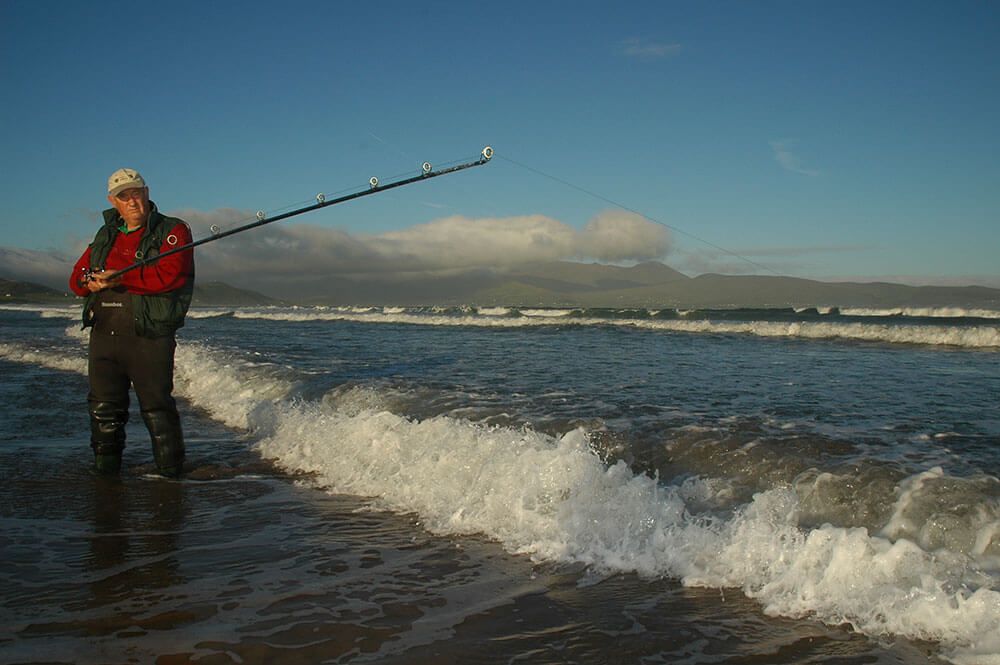
Top reels to go with this type of rod would be smaller multipliers such as the ABU 6500 series, which have been a classic surf bass reel for several decades now due to their casting ability with lighter leads. Other companies such as Tronixpro, Daiwa and Akios do similar reels. If you prefer the simplicity of a fixed spool reel, look at reels in sizes 5500 or 060 sizes holding around 250 to 300-yards of 15lb line. Good examples are the Penn range including the Slammer, Spinfisher and Clash, also reels of similar design from Shimano, Daiwa and other companies.
You can fish with 15lb line and a 30lb to 40lb shock leader. However, if you can fish with a 2oz to 2.5oz lead, then 20lb mainline straight through will be enough without a shock leader to take the force of casting, even to longish range. In shallow clear water, heavier shock leaders can put some fish off, so where possible eliminate them, providing it is safe to do so.
Lead weights will typically be 2ozs to 4ozs and should be grip wires in normal surf conditions. You can use a plain lead and let the tide wash this around in a semi-circle back to shore to cover more ground but choose a lead heavy enough to only slowly move across the sand by tidal pressure on the line.
For heavy surf conditions, or when fishing deeper steep-to beaches, then a standard beachcaster between 12ft and 13ft and rated to cast up to 6ozs will be needed. Match this to a heavier duty multiplier such as the PENN 525Mag 3, or a similar reel.
The alternative more heavy-duty outfit is to go for a European style rod between 14 and 15ft, combined with a 7000 or 8000 sized fixed spool reel and load with 30lb braid and use a 60lb braid shock leader knotted using two Grinner knots back to back. This forms a relatively small knot that flies through the rod rings easily and proves better than mono in most circumstances.
Due to their extra length, these longer rods increase the speed of the lead weight, which in turn increases casting distance.
How to build a surf bass fishing rig
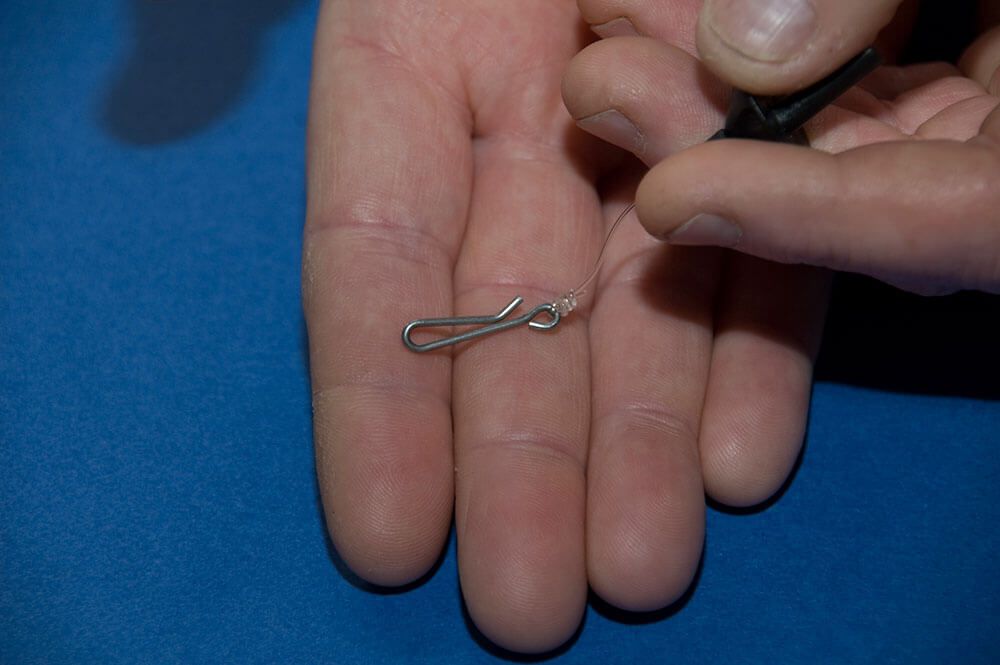
1 - Begin with about 30-inches of clear mono. To one end tie on a Gemini lead link.
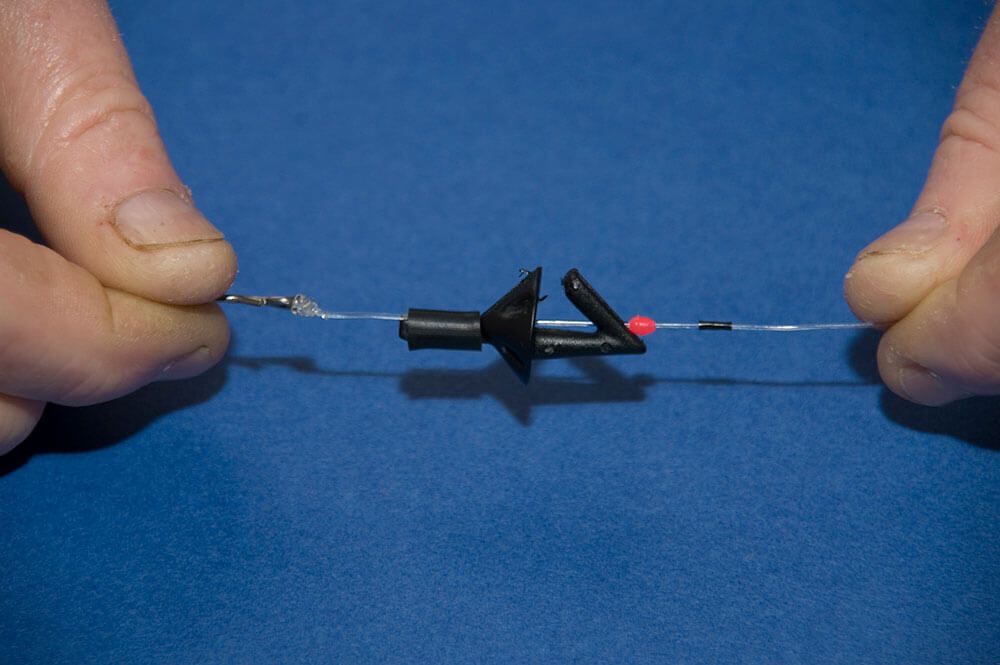
2 - Slide on a Breakaway Impact Shield followed by a 3mm bead and a rig crimp. Crimp the Shield in place 2-inches above the lead link.
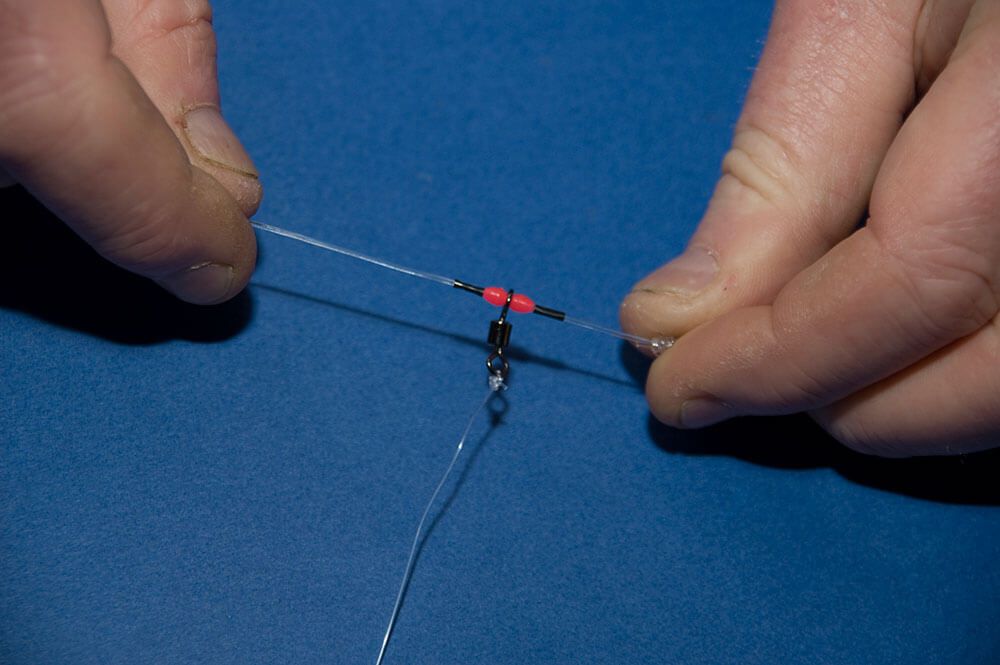
3 - Now slide on a rig crimp, a 3mm bead, a size 10 rolling swivel, another bead and a crimp. Leave these loose for now.
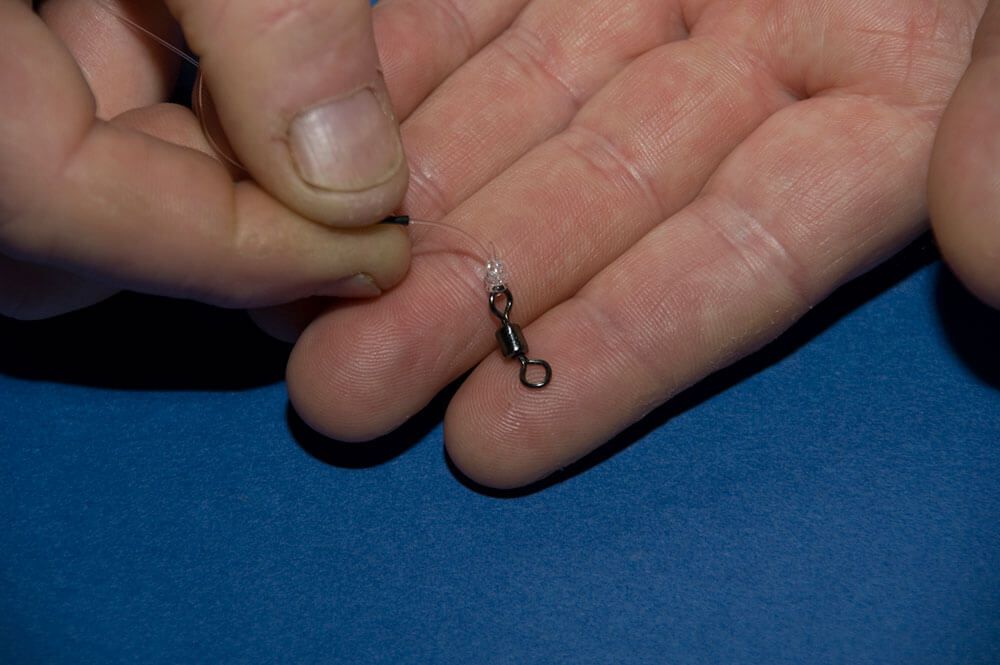
4 - To the free end of the 60lb line tie on a size 4 rolling swivel.
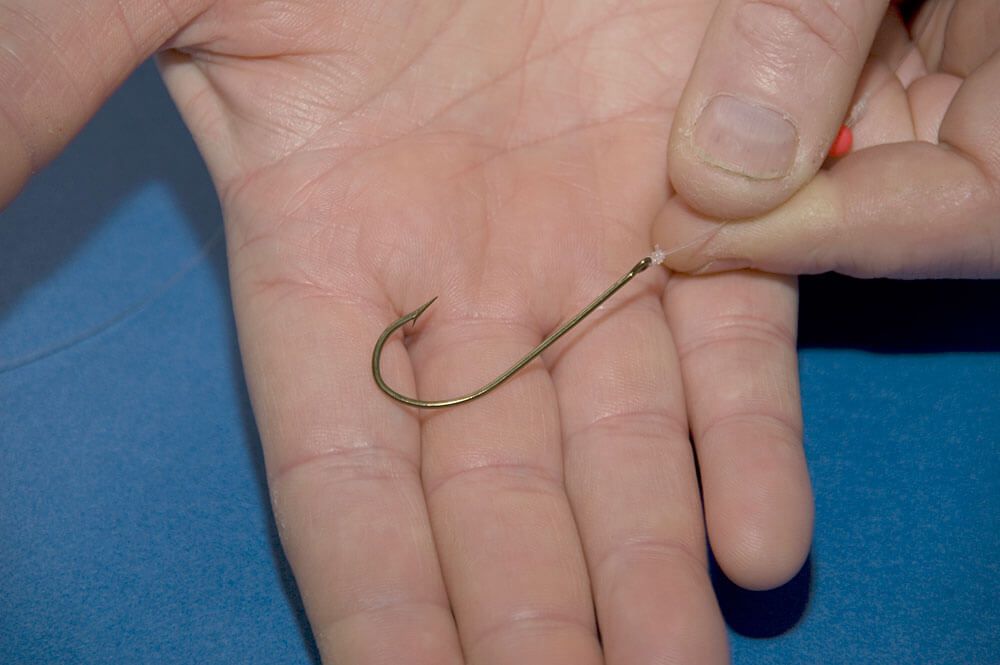
5 - To the hook trace swivel tie on 20-inches of 30lb Fluorocarbon line, alternatively clear mono. To the end slide on a 5mm bead and add a single size 2/0 Mustad Viking 79515 hook.
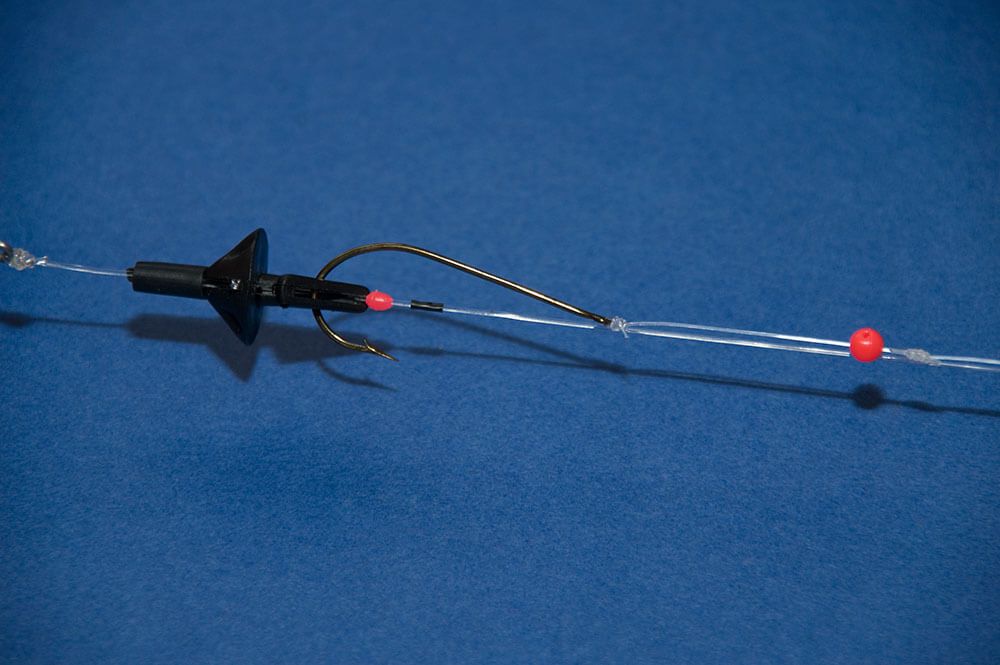
6 - Position the Impact Shield just above the lead link and put the hook inside the clip of the lead link. Slide the hook trace swivel and crimp assembly up the rig body line until the hook trace comes just tight and crimp the trace swivel in place.

7 - Above the 5mm bead tie on a stop knot from 14lb Powergum to act as a bait stop.
Follow our guide on how to build a surf bass fishing rig in our sea fishing rigs section.
Lugworm, either blow or black lug, would be the most consistent bass bait in the surf. Ragworm also works but is never as reliable in the surf as lug is. When baiting with lug, always nip the sandy tail off a short way below the body, then slide the worm, tail end first, over the hook point and around and up the shank of the hook. This puts the fat juice-filled head of the lug's body at the hook point.
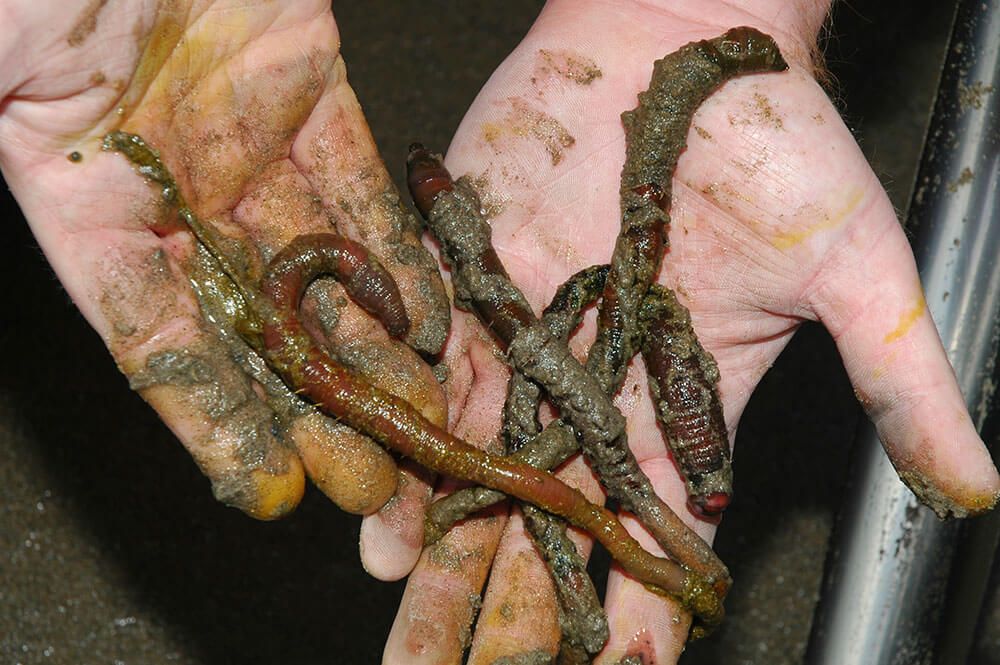
Sandeel is another good surf bait for bass, either used as whole small sandeel with the head and tail cut off and simply threaded over and up the hook, then bound with bait elastic for security. Alternatively, use 3-inch sections of larger sandeel like launce, and again use bait elastic for security on the hook.
Peeler crab can be a good surf bait if you're fishing close to the rougher ground. It seems less effective over clean sand. The best presentation is to use crabs about the size of a 50p piece, remove all the body shell, cut the bait halfway into the body, then thread the body around the hook shank then secure with bait elastic to form a rough sausage shape.
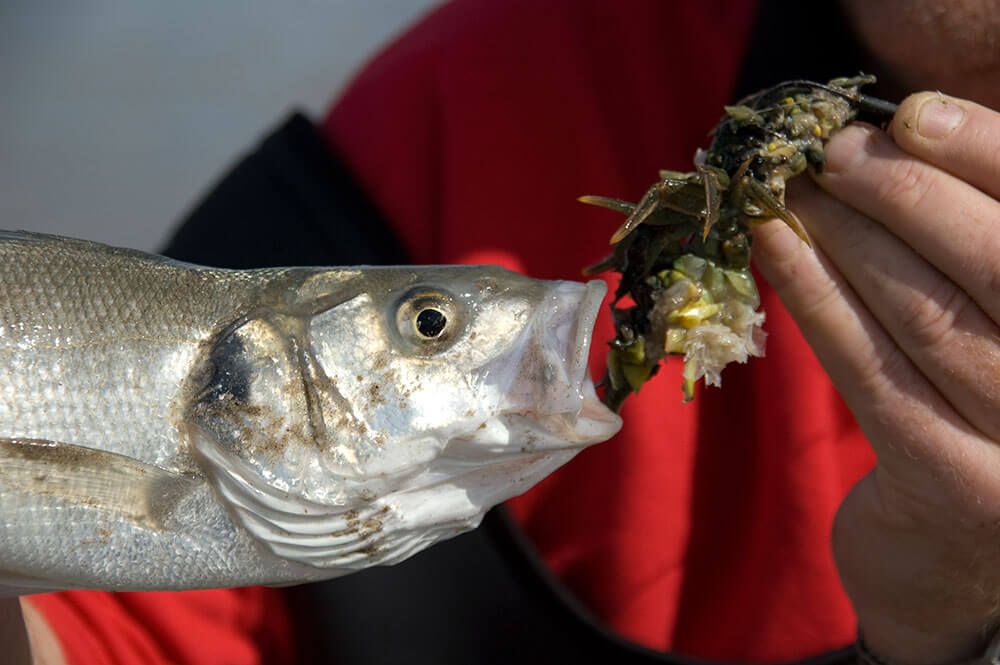
After storms, razorfish can be deadly, as can queen cockles, and in the autumn period, bigger bass will also take mackerel heads simply hooked through the two jaws or between the eyes, whole squid and half body sections of bluey. Again, bind these baits well with bait elastic for improved casting strength.
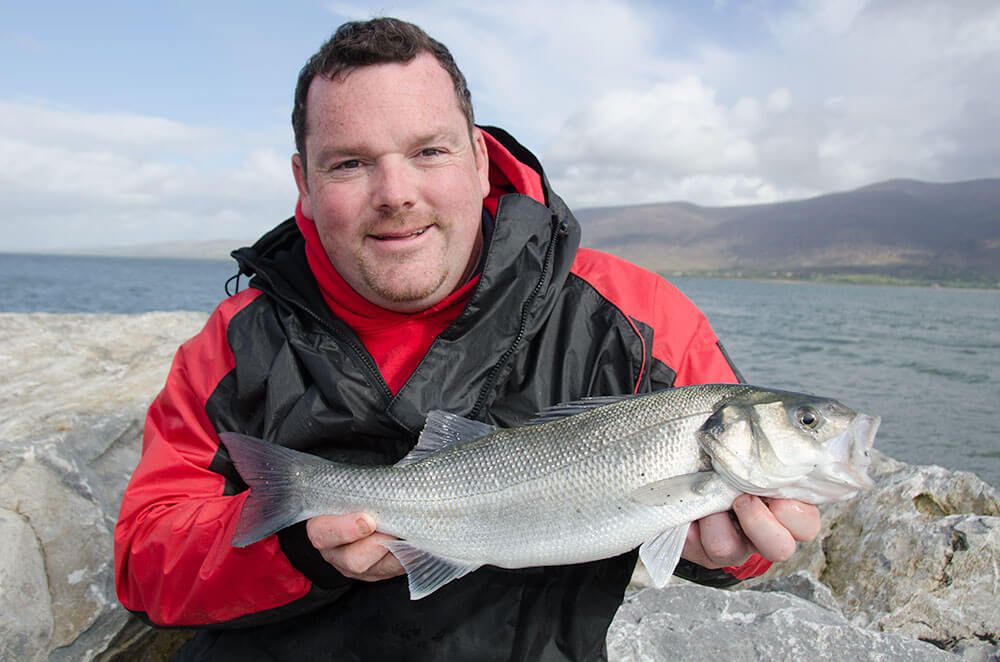
Big bass can show up anywhere, but good areas are the North Foreland of Kent, the Sussex coast, rough ground in Devon and Cornwall, the Bristol Channel, and especially the west coast of Wales. Of late, Luce Bay has also produced some bigger fish from the rougher ground. The Wexford, Cork and Kerry coasts of Ireland are also a rough ground bass mecca.
The season starts at the beginning of April and coincides with the first real flush of the peeling crab. Bass numbers improve through May, then peak in late June just as the crab peel starts to wane. Although some bass will always be present on rough ground beaches, especially during rough seas, their numbers drop dramatically in July through to mid-August when the crab peel in fewer numbers, also the bass tend to move out onto offshore reefs and target small fish such as sandeel and joey mackerel. They come back on to the rough ground in late August and feed there until Christmas in milder years, with crab again the primary food source alongside fish.
Generally speaking, bass on rough ground prefer the bigger sized spring tides. The peak tides are those the three days before the very biggest tide. Fish can still be caught on the dropping tides after the highest spring, but overall numbers of fish will decrease as each dropping tide passes.
Low water is a good time, especially if it coincides with dusk or dawn, but the bass tend to work a rough ground beach for the first two hours or so of the flood, then move elsewhere, returning for the hour either side of high water. Darkness is always good as the fish feel safer when working very tight to dry land.
Ideal weather in daylight is an overcast day with a light force two to force four wind straight in off the sea. That said, calm conditions can also surprise with the odd fish. Rough seas can be very good, but generally, you'll need to cast further to find the fish.
The best rough ground bass anglers develop the ability to read the beach and to see where the bass will work looking for food. At low water, look for small finger reefs that run inwards up the beach. These are natural edges that will trap food as the tide floods in. Also, look for areas where bigger, heavier stone sits amongst smaller stone. This rougher ground traps more food and has more hidey holes for crabs and small fish to live in. Also note depressions in the stones that hold water as these too, will trap food. Another hotspot is a much bigger than average boulder. These often have depressions dug out by the tide around them and again collect food. At high water, do not be afraid to fish just 10 to 20-yards out from the high-water line. If you keep quiet and out of sight, bass will be almost at your feet.
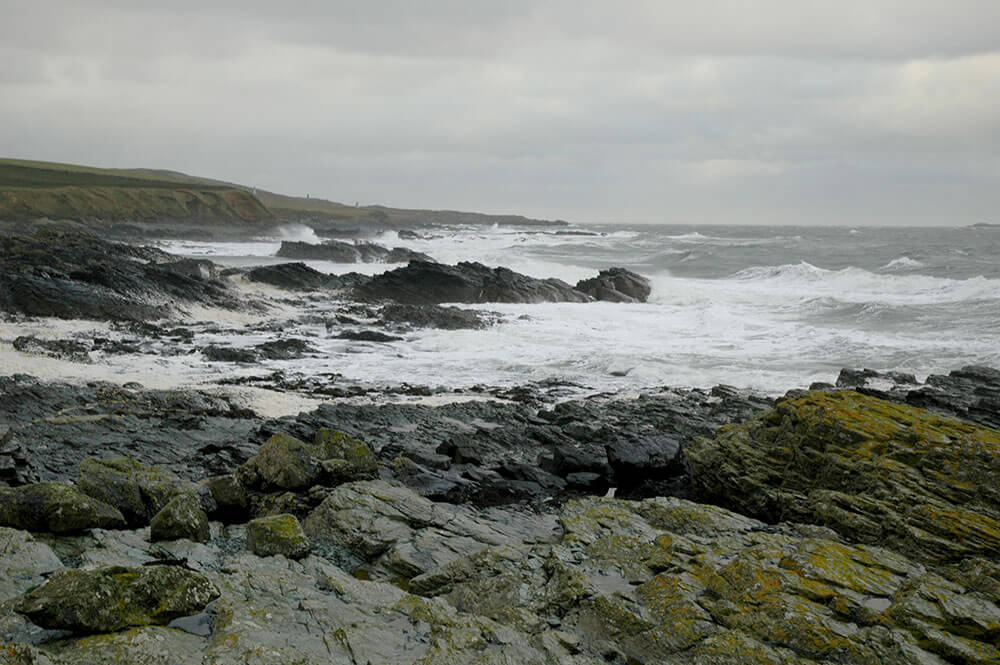
Rods are the same 2oz to 4oz rods used for surf fishing and need to be between 11ft 6ins and 11ft 9ins ideally. Choose one with a semi supple tip so that you don't smash soft crab baits during the cast, but with rapidly increasing power in the mid-section and a stiff butt so that you have the power in the upper mid-section and butt to bully big fish away from potential snags.
Good reels are the ABU 6500 range and similar loaded with 20 to 25lb line, or in extreme cases the Penn 525 carrying 25 to 30lb line. You will not be fishing at long range over rough ground with most casts being less than 50yds, so these reels can carry more than enough line in these higher breaking strains. Alternatively, use a 5000 to 5500 sized fixed spool reel again loading with 20lb mono main line.
Some anglers like to use a heavier 40lb braid on the fixed spool reel, as the braid does not stretch and gives slightly better bite detection, but what they forget is that if you feel the bass, the bass feels you and braid can result in dropped baits when fishing at close range.
Another option, and often a good one, is to use a Fluorocarbon mainline. This has the advantage of being less stretchy than mono, so improves bite detection, but also is less visible to a fish working in clear shallow water. It is also more abrasion resistant than mono when encountering boulders, barnacles and stones.
There is no need for a shock leader when using lines over 20lbs as the lead weights used will be less than 3ozs typically and you're not power casting. If you do need longer range to reach rough ground, then add a 30 or 40lb leader for leads up to 4ozs and increase the line used to make the rig line to the lead weight appropriately.
How to make a rough ground bass rig
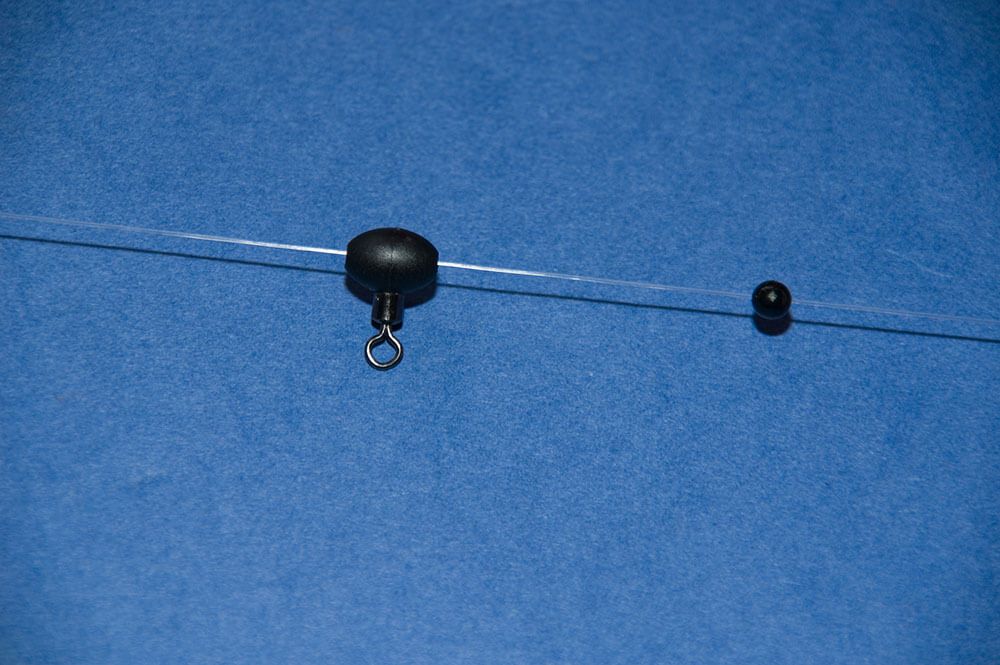
1 - On to the mainline, slide on a Pulley Rig bead, then a 5mm black bead.
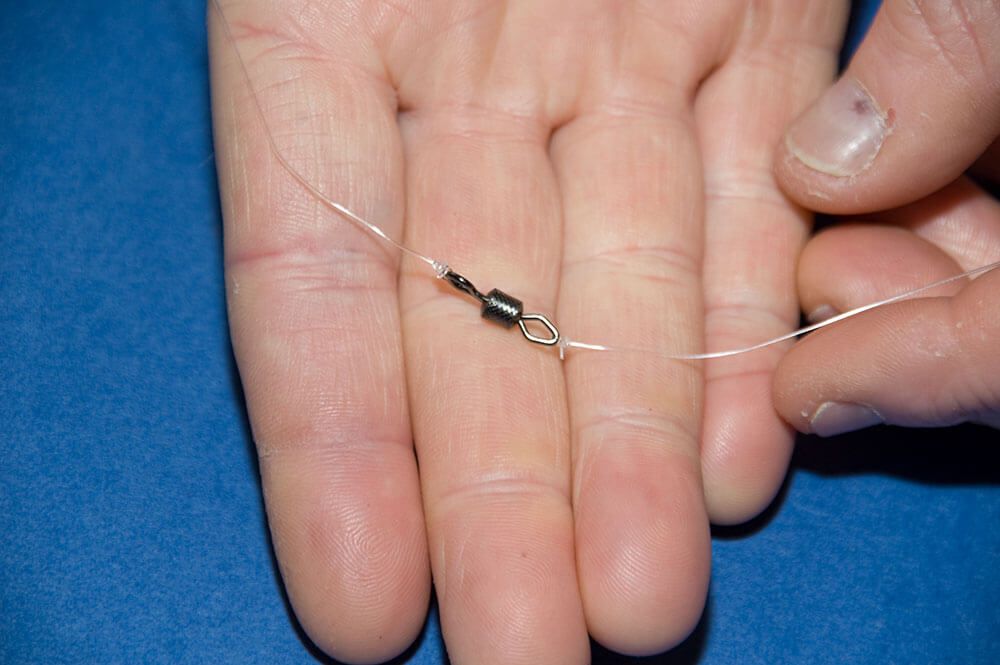
2 - To the end of the mainline tie on a size 6 swivel. To the end of the tied swivel add an 8-inch to 15-inch length of 20lb Fluorocarbon.
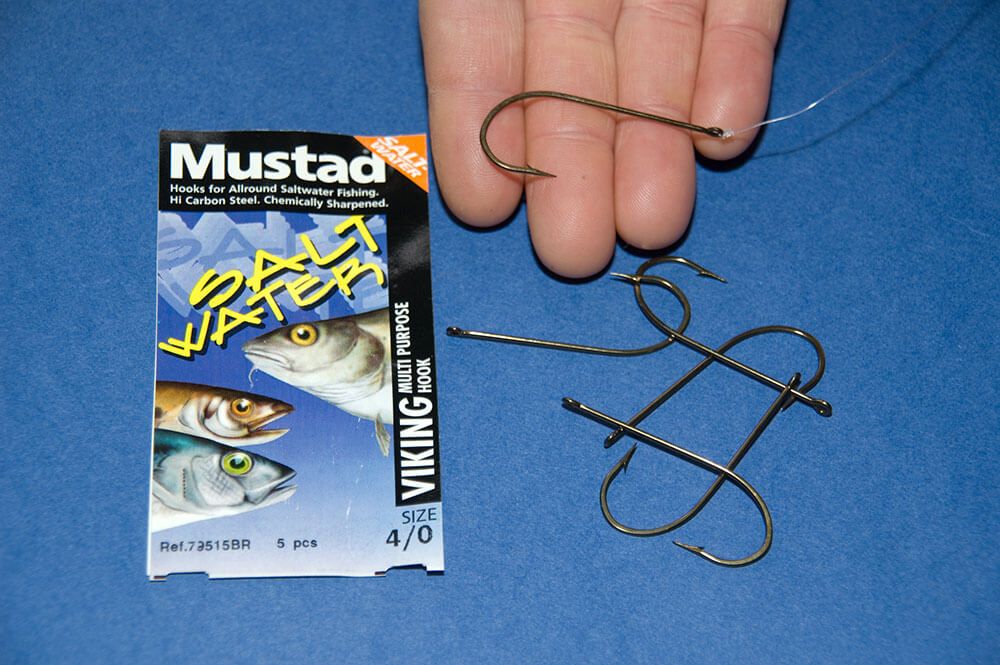
4 - The best hook is a Mustad Viking 79515 size 4/0. Tie this to the short section of 20lb Fluoro carbon.
5 - To the eye of the Pulley Rig Bead tie on an 18-inch length of weaker 18 to 25lb line depending on mainline strength to take the weight. This needs to be a dark colour to match the seabed when fishing in daylight. You can use a small link to attach the weight, but most anglers save tackle and just tie the weight to the line as losses will be heavy when fishing into the rough ground, plus you’re casting minimal distance usually.
Follow our guide on how to make a rough ground bass rig in our sea fishing rigs section.
Crab is the number one bait over rough ground as it is exactly what the bass are looking for. They will also take mussel, again a natural bait over this type of ground.
The usual baits such as lugworm, squid, ragworm and even razorfish will work, but are never as good as crab for overall numbers of fish caught.
How to make a peeler crab bass bait
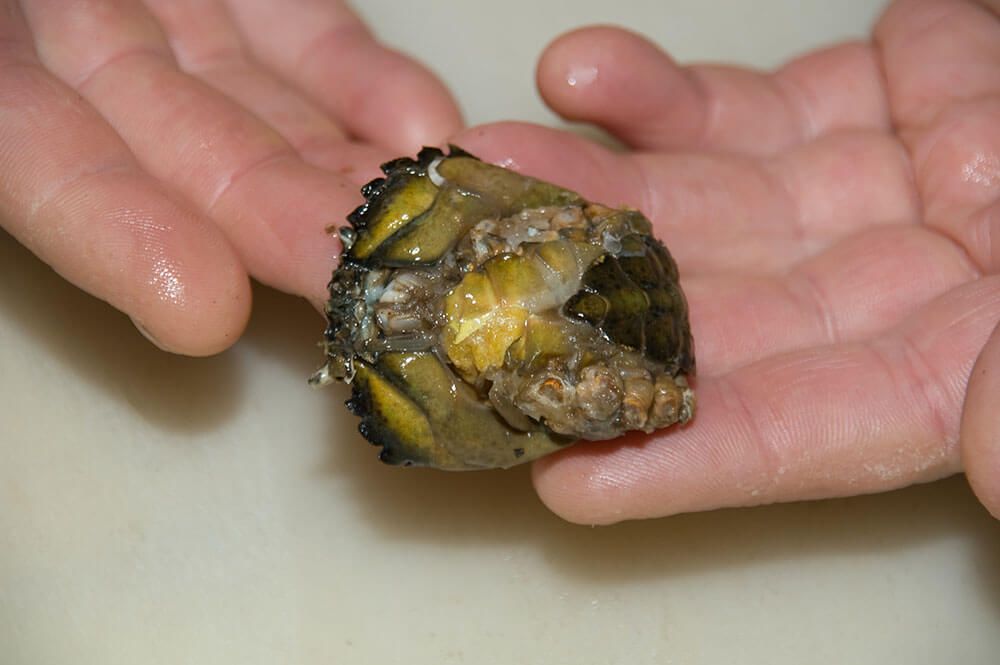
1 - Pinch the crab between the eyes to kill it, remove the legs and claws and peel off all the brittle shell to leave just the soft body.
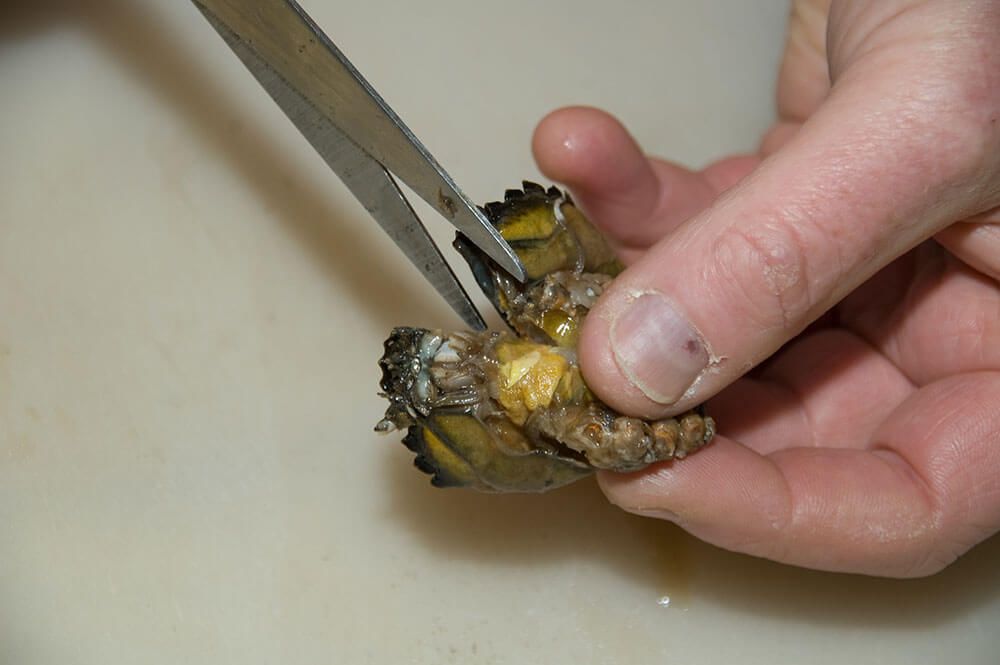
2 - Use scissors to cut half way in to the body from the middle front of the crab.
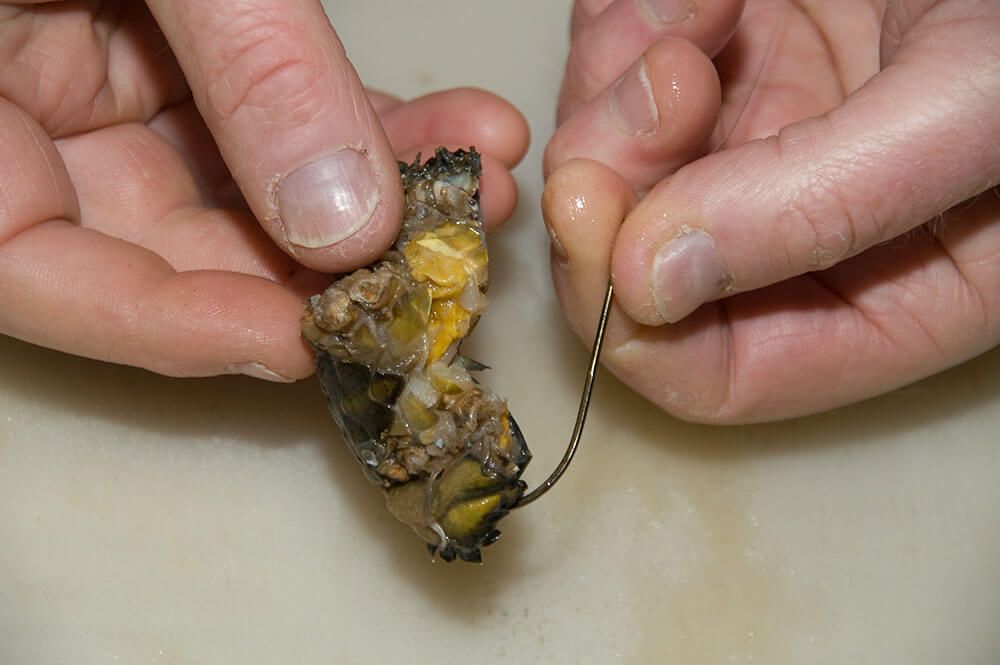
3 - Holding the hook in your left hand, starting with one side of the cut body slide the bait over the hook point and round the bend of the hook and up the shank. If the crab is not big enough to fully fill the hook, add another half or whole body.
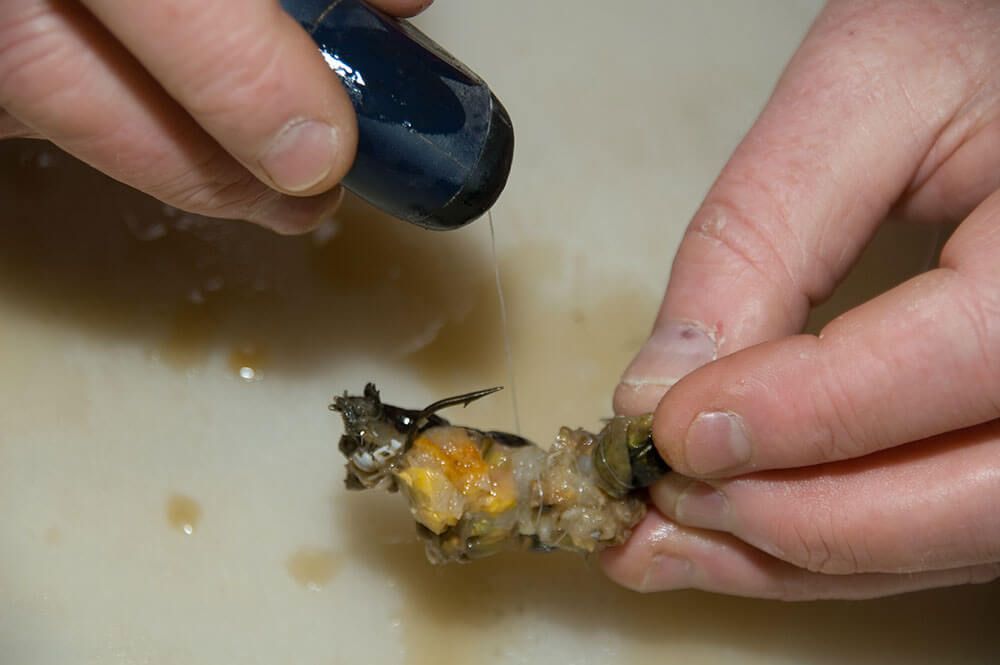
4 - Use bait elastic sparingly to form a rough sausage shape but with lots of juices still able to leak out of the crab body for maximum effect in the tide run.

You would expect a typical rough ground bass bite to be a savage rod wrenching affair. This can happen, but there are many types of rough ground bass bite.
Bass are often shy biters on rough ground and often you'll feel a light tap on the rod tip as the bass blows the crab in and out of its mouth almost testing it. This is followed by a pull-down on the rod tip, which needs to be struck.
Sometimes bass will just move the lead weight and you can feel it slide on the stone. Don't confuse this with the surf or tide, but if unsure, strike anyway!
You will also feel the pressure on the line fall slack. This is a bass swimming in towards you after taking the bait. Wind down hard on the fish retrieving line on the reel and when you feel the full weight of the fish, strike!
If you always hold the rod, you'll get to recognise the full variety of bass bites, but more so, develop a sixth sense that enables you to "feel" that something is happening, even when there is no obvious movement on the rod tip or obvious bite.
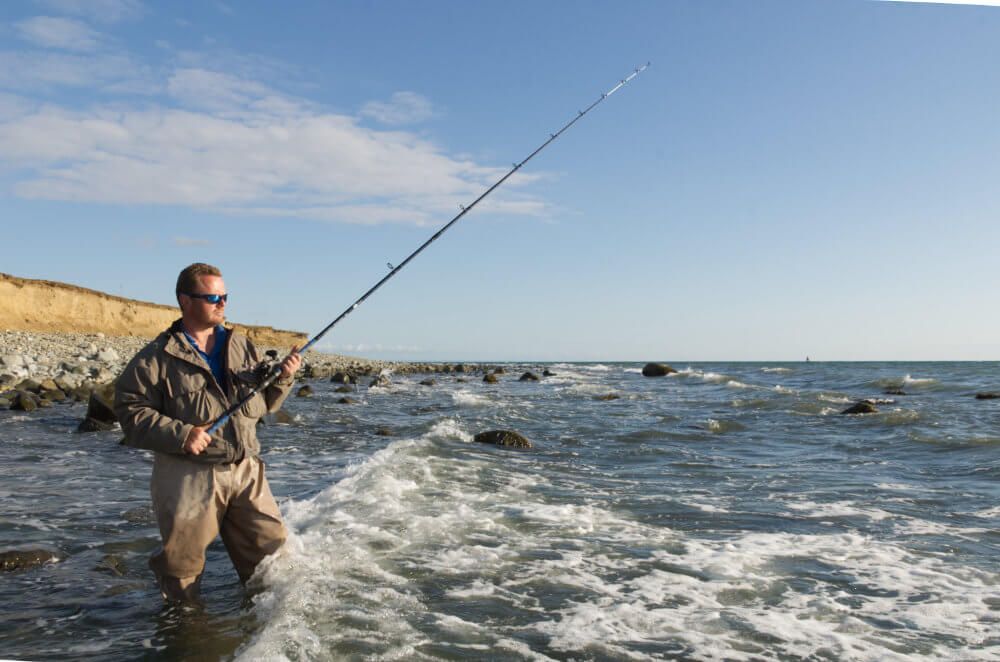
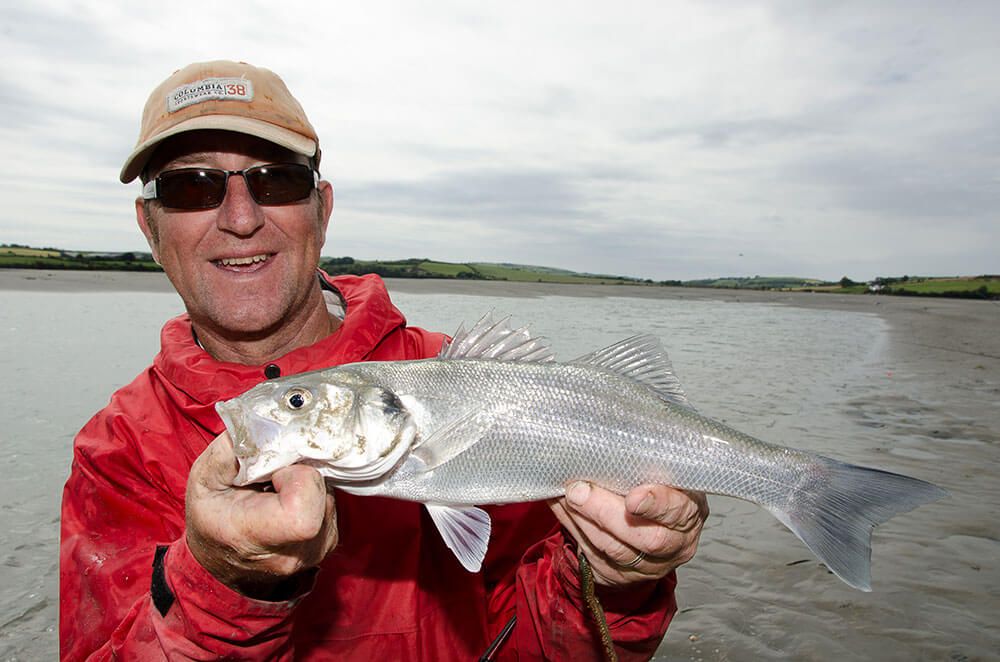
School bass can be caught throughout the year, these being bass up to about 2lbs in weight or so, but adult bass fresh from spawning show first towards the end of March in the south, but more likely in the middle of April in Wales and off Essex, and then on the East Anglian coast by the end of April or beginning of May. Further north it's usually late May on that sees the fish really worth fishing for. They stay until October in the north but can linger as late as Christmas in the south.
Early in the spring, until about mid-June, it's the presence of peeling shore crab that brings the bass in to the estuary. The crab is a reliable food supply and it's no surprise that once the crab start to show, it's only a couple of weeks before the bass are in and their numbers building quickly. By mid-May the bass will also be actively hunting sandeels, also the small sea trout, mini species and small flatfish as their numbers build.
The best tides are the building middle sized tides through to the very biggest spring tides. As soon as the spring tides start to drop back, bass numbers will also ease away. Bass can be caught on smaller neap tides too, but the numbers running the estuaries are usually much less and the likelihood of bigger fish is more remote.
Although bass will work the estuaries in calm, warm conditions, it's in the roughest weather that the bigger bass are more likely. During gales some big bass will come to feed inside the smaller estuaries. Bass will also tolerate some freshwater from the hills but will not stay inside the estuaries if the water is very acidic after major rainfall and flooding.
Day light fishing can be productive, but generally it's at night that the best of the fishing is enjoyed. Especially when low water falls in the dark and the bass move confidently into the estuaries.
Bass wait in numbers at the mouth or bar of our smaller estuaries and will move in as soon as the new tide starts to push. They use the tide to help them travel miles inland. Initially they travel through the main channel working seed mussel beds and any patches of rocky ground. They will quarter around small jetties, piers, harbour walls, breakwaters, and through small harbours. They move into the drainage channels drawing water off the salt marshes targeting crab, small fish and sandeel, but also work through weed and muddy boulder ground sniffing out crabs and small fish.
Another good spot is where a smaller estuary bottlenecks and narrows forming a fast moving current. Bass use this fast running tide to push sandeel shoals up against and make them easier to pick off.
Bass can still be caught on the ebb tide as they run out of the estuary, but they are cautious of being cut off and tend to work the edges of the deeper main channel as they drop back, and especially like areas where surf is evident as it breaks over shallowing sandbanks on the seaward side.
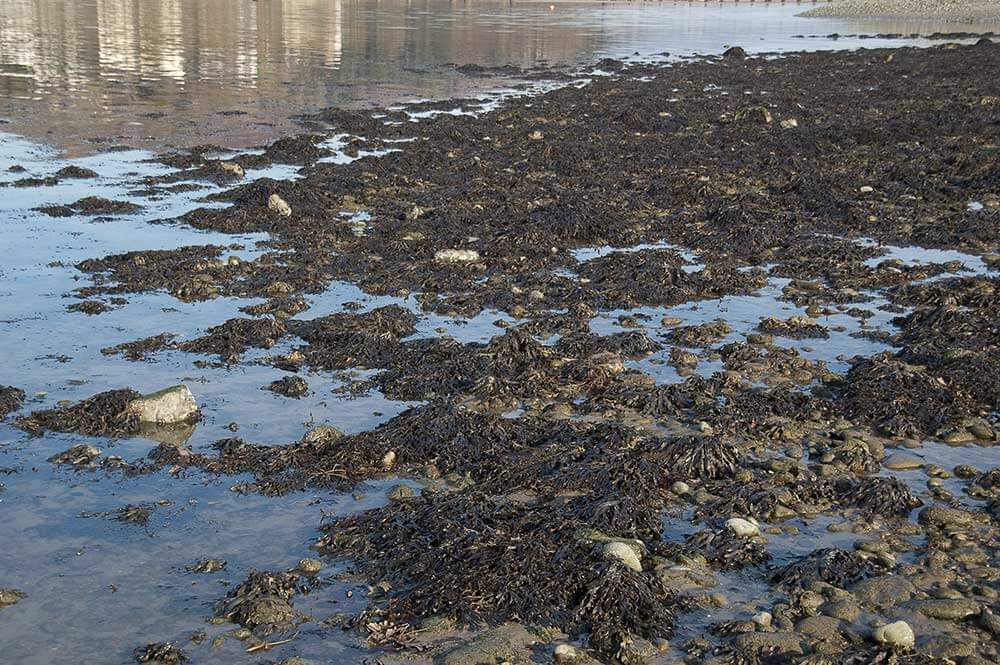
For general fishing for bass a 1-3oz or 2-4oz Bass rod about 11'6" is perfect matched to a light 5000 sized fixed spool reel such as the Penn Slammer or Clash, or a similar Shimano or Daiwa reel. Line strength needs be no more than 12 to 15lbs, though some anglers prefer to load with 20lb braid.
Anglers fishing rough weather and in estuaries where the tide run is fast with maybe some floating weed and with big fish in mind, they would choose the 2-4oz bass rod, again 11'6" in length, married to either a 6000 sized fixed spool reel or a small multiplier such as one from the ABU 6500 series, with Penn 515's also popular. Line strength would be 15lbs, possibly up to 20lbs if fishing in amongst snags.
For any casting also add a shock leader. These should be 30lbs for leads up to 3ozs, and 40lbs for leads up to 4ozs. Always use a clear leader for daylight bassing as bass can shy away from bright colours. Fluorocarbon is a better leader material than mono for this as it is more abrasion resistant and less visible to the fish.
How to build an estuary bass rig
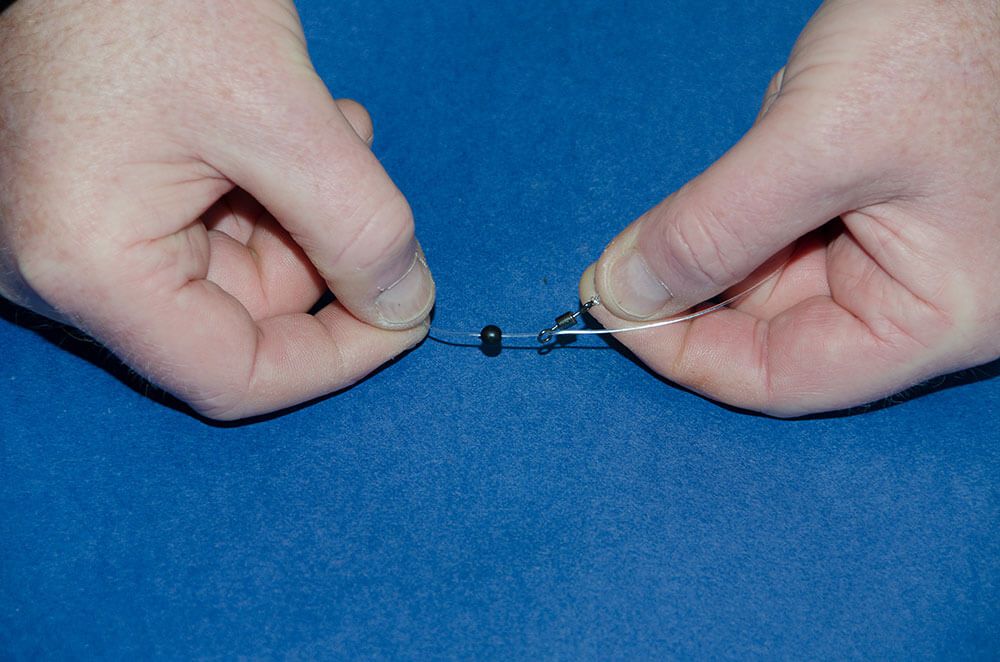
1 - On to your leader slide on a size 6 rolling swivel followed by a black size 5mm plastic bead.
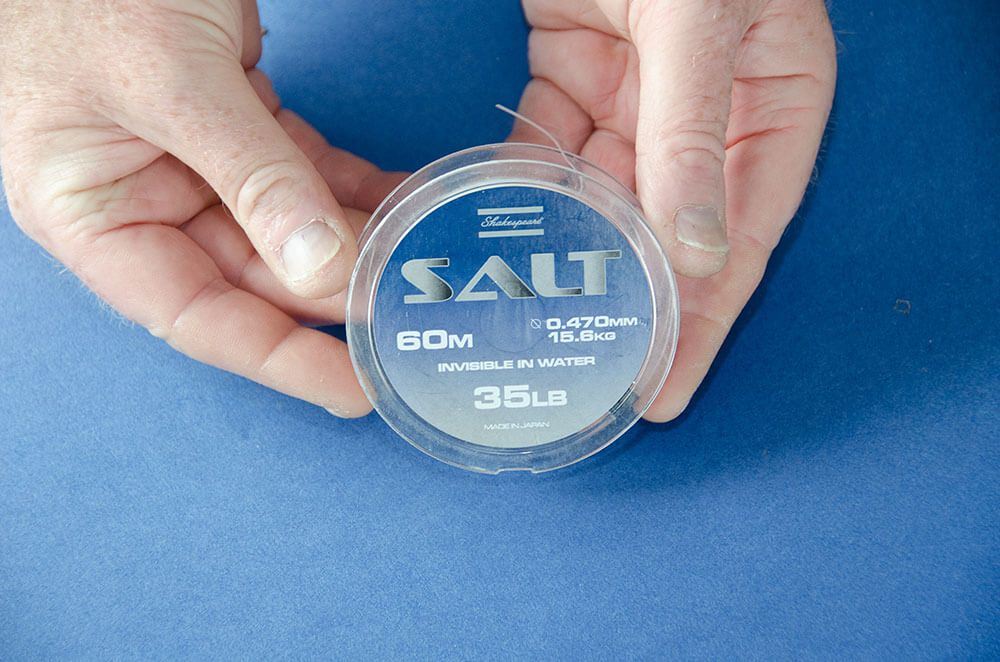
2 - To the end of the shock leader tie on another size 6 rolling swivel. To the sliding swivel tie on 24-inches of 30lb to 40lb Fluorocarbon.
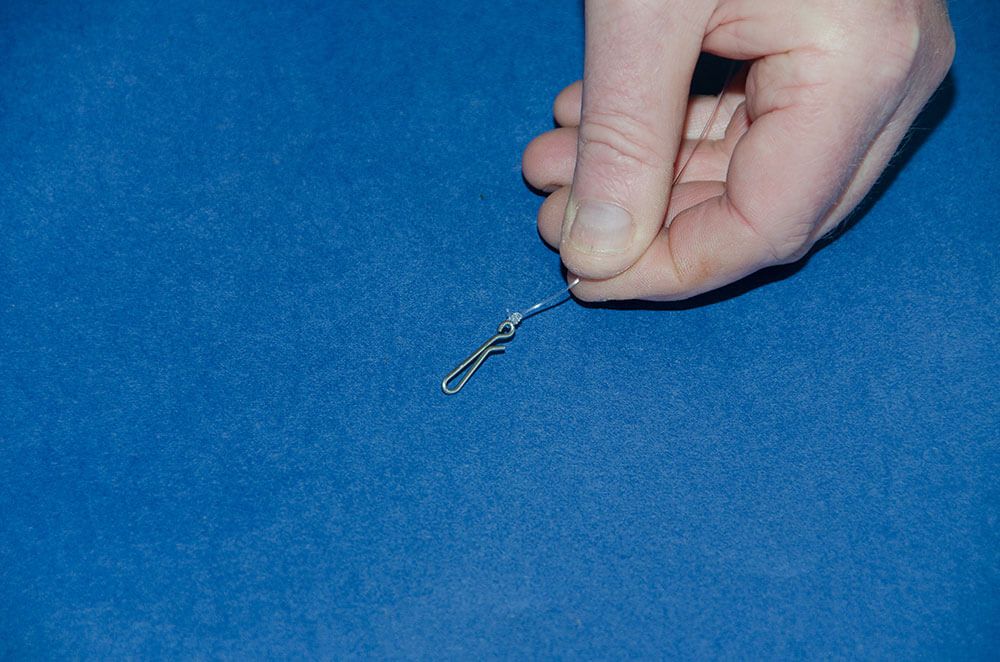
3 - To the end of the Fluorocarbon tie on a Gemini Lead Link to take the weight.
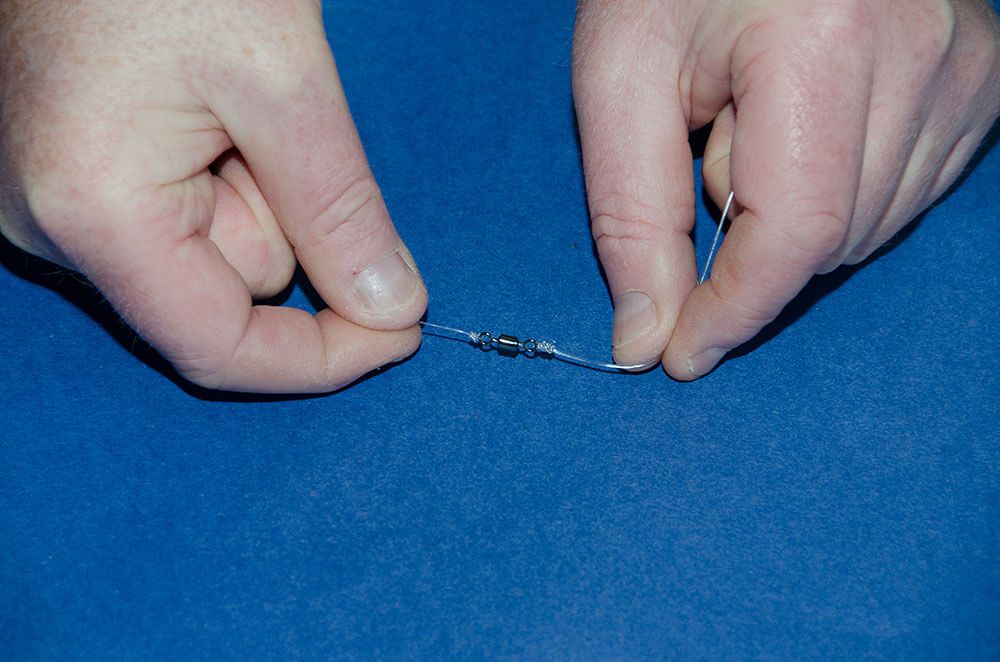
4 - To the end of the swivel tied to the shock leader, tie on 15-inches of 20/25lb Fluorocarbon or clear mono to form the hook length.
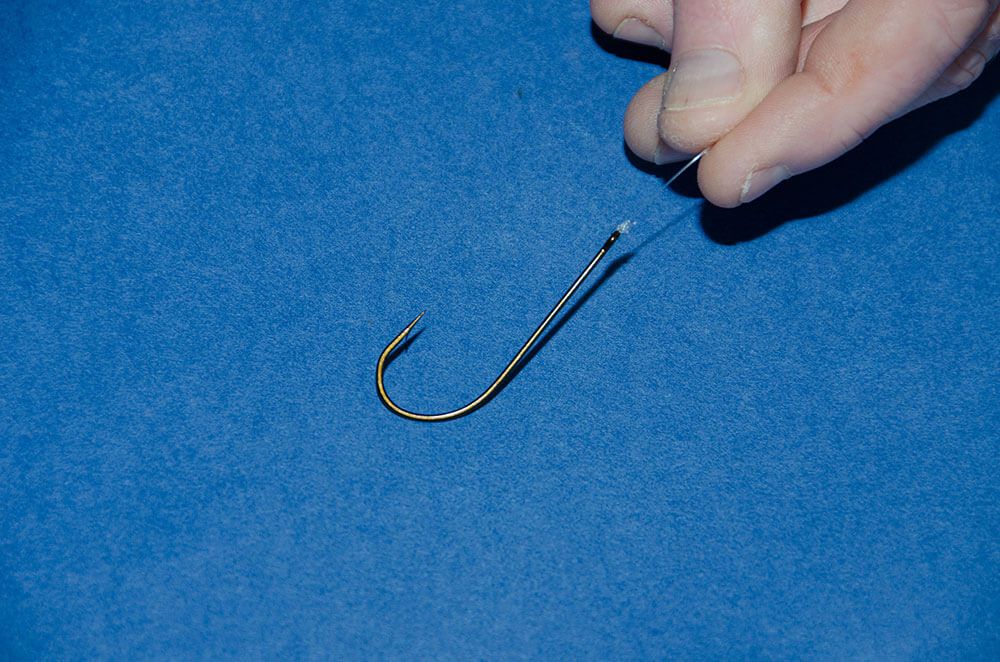
6. To the end of the hook length tie on a size 4/0 Mustad Viking 79515 hook, or similar Viking type pattern from Sakuma or Varivas.
This rig gives excellent rod tip and hand felt bite detection as the hook and main line are pull in the same direction, but also it maximises the power of the strike directly to the hook. That said, with the sliding swivel, a cautious bass can be allowed to pull line freely through the sliding swivel without fully feeling the lead weight. Fish as light as you sensibly can, and you will catch more bass as a result!
Follow our guide on how to build an estuary bass fishing rig in our sea fishing rigs section.
As we've already seen, from late March through to June fresh peeler or soft crab will be the magic bait for estuary feeding bass. However, from mid-May onwards, and especially from mid-June when the crab peel falls away, the bass will move on to a fresh fish diet targeting sandeels and smaller fish. Worm baits generally, tend to catch the smaller fish.
To bait with peeler crab, first fully peel a dead but fresh 50p sized peeler crab, then cut the body in half. Push the two halves up on to the shank and bend of the hook leaving only the hook point clear of the bait, then bind the bait to the hook with some good tight turns of bait elastic. Big bass will hit big baits, but baits above the size of a standard small matchbox will see your bites ratio reduce.
Frozen sandeel is a good estuary bait. Simply pass a long-shanked hook down through the mouth and out through the gill, then stitch it twice more in and out of the body to leave the hook point clear about halfway down. Add a few turns of bait elastic around the head for casting security.
Later in the season and into Autumn, a fillet of mackerel or bluey, whole squid, soft or peeler crab, also big worm baits will take bass as they feed up for winter. Another good estuary bait, especially after an autumnal storm is razorfish and mussel.
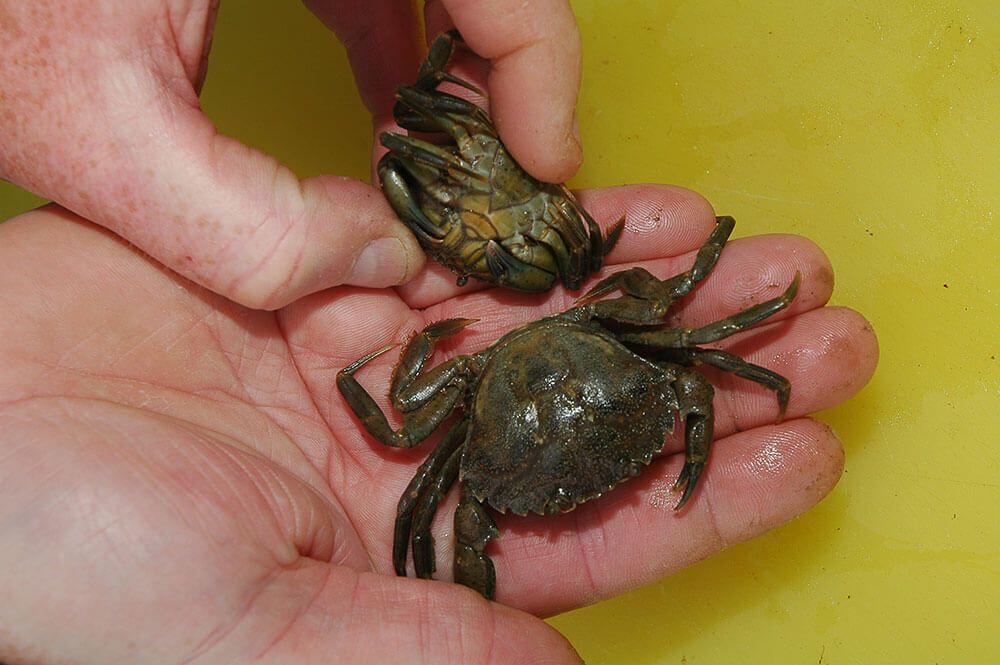
A forgotten bass tactic is pure and simple freelining. It's not commonly used even by experienced bass anglers and yet it is the most effective form of fishing at close range over rough ground or in shallower estuary side creeks and around weed banks.
The phrase some carp men use when stalking carp working tight into the margins is "combat fishing" and this is the perfect description and it applies just as much to close quarter bassing with freelined baits.
Experienced bass anglers will tell you they can often be stood on the tide line and watch bass just a few feet away from them working through the boulders, dorsal or tail fin right out of the water, oblivious to the angler nearby. These are the fish you target with freelined baits.
Freelining really comes in to its own from mid-April through to late June, then again from mid-August to late October when the crab are peeling in good numbers and the bass run through the rocks and boulders pretty much every tide. At this time, during the first hour of the flood and the hour either side of high water, bass will work very close into the tide line, often in just a couple of feet of water.
The best tides will be the bigger spring tides. Always the best fishing will be on the tides that fall in the three days prior to the biggest tide of all. This is when the largest numbers of bass move inshore to feed. Immediately the tides start to fall back towards neaps the numbers of bass fall inshore and you're fishing to a much reduced audience.
Dusk and dawn, as ever, are great times to be fishing, especially if it coincides with low or high water. Equally fishing a low or high tide in full darkness can also be very effective under the light of a light sky or moon.
Never rule out full daylight, but ideally you need to be fishing on the more overcast days, better still if it's drizzling or raining, the water carries just a hint of colour and a light breeze roughens up the seas surface to inhibit light penetration. In short, it's less easy for the bass to see you!
Hot spots for bass are areas where the smaller boulders are broken up by any bigger boulders as this will hold the crabs better. Perfect spots are depressions in the boulders that hold water when the tide has receded, and you should make special note of where these are for when the tide floods in. Any food pushed along by the tide gets dropped in here and the bass will always work these holes.
Other good spots are the deeper edges of shallow rising finger reefs running shoreward, small patches of sand amongst rough ground and areas of weed.
Freelining also works when casting along the edges of weed covered estuary sides and into shallow drainage creeks, again during the flooding tide.
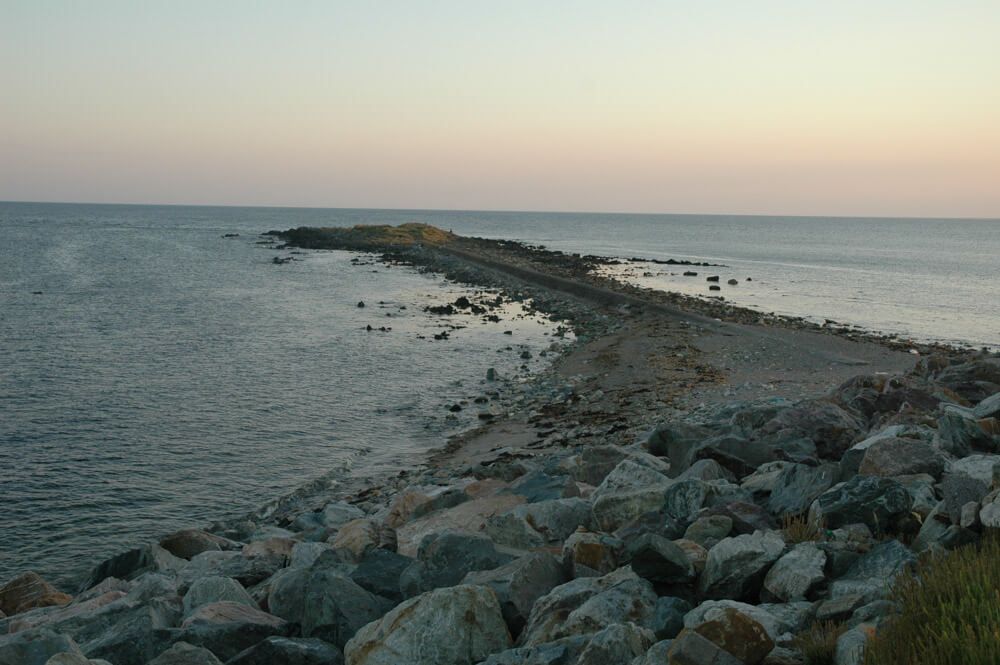
Tackle is kept very simple. Choose either a 9ft 6in spinning rod capable of casting up to 3ozs or go for a full 2-4oz bass rod, but make sure the latter is a very light example as you will be holding it all the time.
The only reel for consideration is a fixed spool reel. An 040 to 050 size is ideal and light in weight. Choose a model with a good front drag system such as the Penn Slammer 4000, Penn Clash 4000, or equivalent Shimano or Daiwa.
The big debate is mono or braid line? Braid is often preferred for a couple of reasons. Firstly, you're literally feeling for bites from fish that might be just 10ft away. The braid line is so sensitive that when your instincts become fully attuned to freeline fishing you'll sense the fish close to the bait before you feel the bite proper. You might not believe this...but don't doubt this until you've experienced it for yourself. Also, the braid catches the tide less and gives a more direct pull of power to the hook point when striking for such close quarter reactive fishing.
When fishing braid, choose a soft supple type such as the Berkley X9 in 20lb or 30lb breaking strains depending on the severity of the ground you're fishing. It always pays to add a short 5ft section of 20lb Fluorocarbon line to minimise visual contact between the braid and the fish but also to just give a hint of elasticity when playing big fish right under the rod tip.
Mono is okay though, but I'd suggest using one of the better quality Fluorocarbon reel lines in 20lb such as the Berkley Trilene as it's less easy for the fish to see at such close range.
There is only one hook to really trust, the Mustad Viking 79515. These have a knife-edge point and can be honed to maximum sharpness easily. The size 4/0 is ideal for big crab baits but choose the size of the hook to suit the size of the bait.
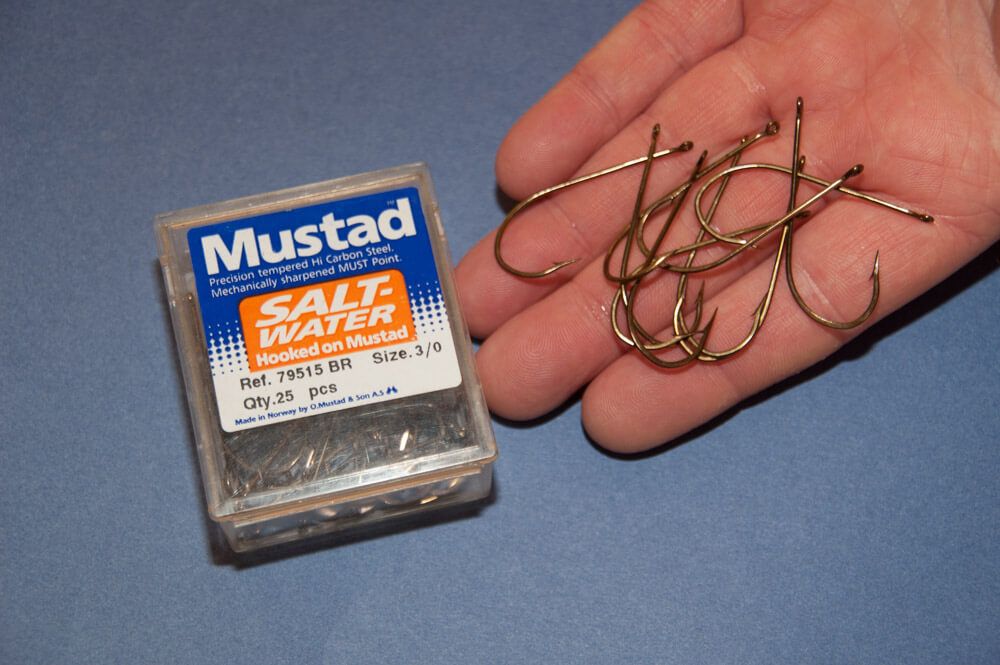
Keep tackle carried to an absolute minimum. You only really need bait elastic, a small pair of scissors, a honing stone and a few spare hooks. Put your crab in a small pot or bag you can easily carry. The worst thing you can do is to keep walking backwards and forwards up and down the shingle or rocks as the fish will see or hear you and vacate the immediate area. Once you start fishing, keep still and make no noise.
Other essential items are a baseball cap and a good pair of polarised sunglasses which are essential for helping you spot fish before they spot you when fishing in daylight.
Crab, crab, crab and crab is the straight answer! Shore peeler crab is the main bait as this is what the bass come into the rocks and creeks looking for. Maybe slightly better is a just popped big softie that just oozes out juices.
Don't be afraid to use big baits. Use one big peeler or use two smaller ones to form a bait a good 2-inches long. Kill the crab and peel it of all the brittle shell but leaving the legs on both sides. Cut the body halfway through then bend the body around the hook and thread the crab fully on to the shank. Use just a few turns of elastic to secure the legs to the shank of the hook. The other legs are left to dangle below the bait to add some movement as the bait washes around.
You can do the same with a couple of smaller soft crab, but you don't need to cut them as they'll break up a little when being put on the hook.
Big softies need to have the hook passed through the back and be brought out and upwards through the belly. Use elastic if need be, but on big softies at very close range, sometimes just a gentle lob is enough, so the elastic is unnecessary. Don't worry too much if the hook point is not fully clear. A hard strike will see the hook come through the softie and into the mouth of the bass. This size of bait has the weight in itself to be easily cast 20yds or more.
The art of freelining is concealment. Use any cover available. This will usually be behind big boulders, or at least try and break up your outline by sitting low behind any tree trunks or old lobster pots washed up on the shore and keep still.
A tactic I've used many times on rough ground backed by shingle is what military snipers call "the grave". You scoop out a shallow depression in the shingle and literally lay on your side with the rod facing at an angle across the sea. Bass will see up through the water column and at a shallow upward angle beyond that. If you're below that angle they'll never see you.
Make the cast and literally let the bait wash around in the swell. Only retrieve a little line if the bait is being washed inshore quickly. If possible, just let the bait sit on the seabed and just occasionally twitch it a little by either pulling on the line by hand or slowly moving the rod tip.
Ignore the rod tip as a bite indicator. You will always see the bite via the lift and tightening of the line first. As the line lifts, ready yourself, and as you feel the weight of the fish come up against the rod tip only then do you strike and strike hard to set the hook.
The first tactic of the bass will be to turn and bore out seawards, then throw its head around a few times, then turn and run again this time with the tide direction and along the surf tables. Big bass over 6lbs will hug the seabed and thump the rod tip hard as they power for the snags. Don't bully the bass, have faith in the reel drag and drop the rod to the side if the bass tries to run for a known snag out in front of you, which they will try to do, as the sideways rod angle will turn them. You'll know the fish is beaten only when it wallows and thrashes on the surface.
To lift big bass from the water's edge, just use your finger and thumb, thumb inside the mouth and index finger under the chin. Grip them hard and lift then from the surf. This is reliable and will not damage the fish in any way prior to unhooking and returning.
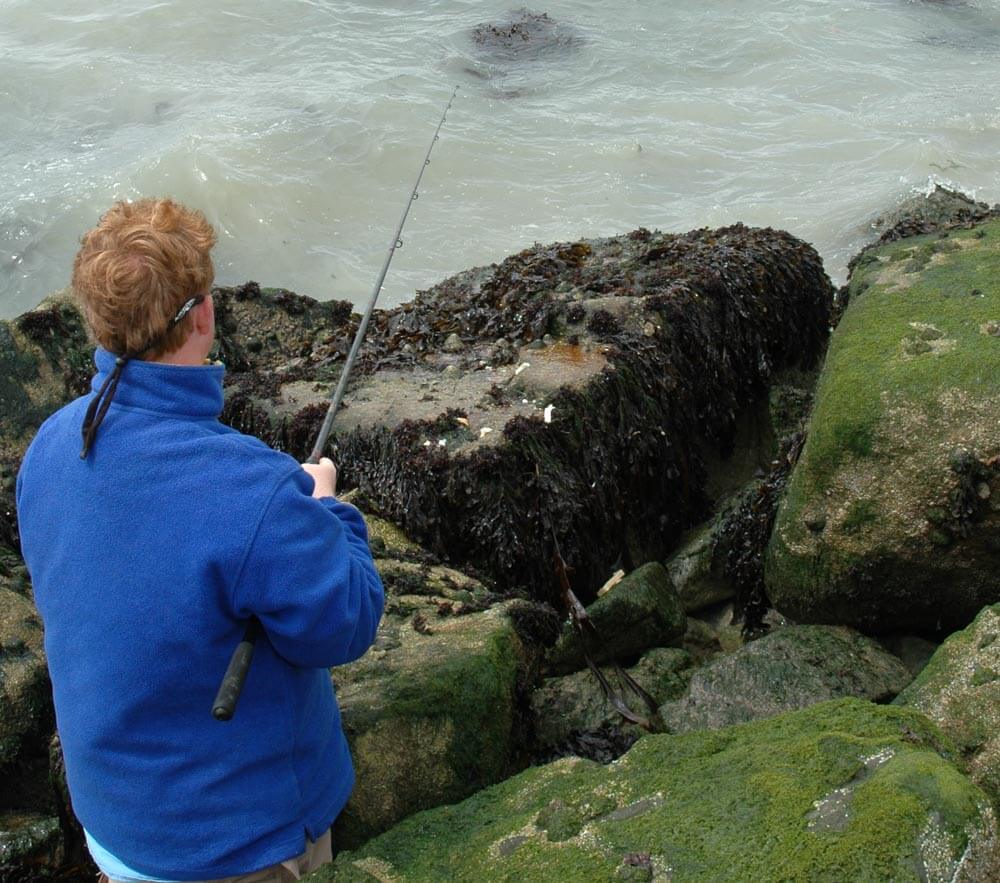
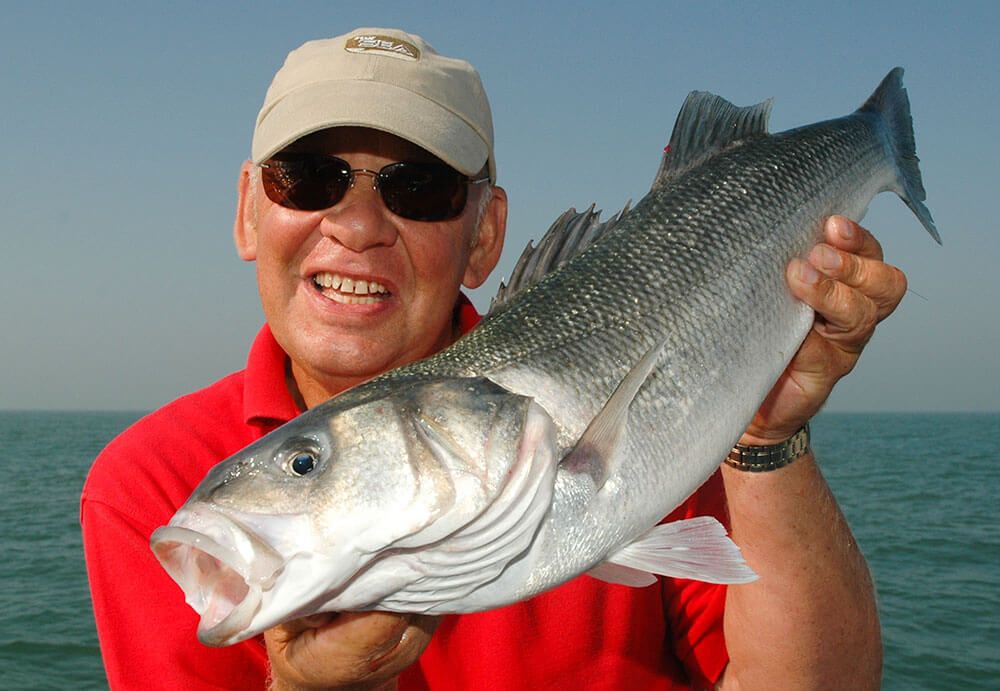
The recognised season for bass is from April through to November, though in Wales and the southern coast of England fish can be caught throughout the year. In warm winters juvenile bass will stay in the estuary mouths and work the adjacent surf beaches continually.
Bass exploit every possible opportunity to feed. They can be found many miles offshore over wrecks in the English Channel and southern North Sea, on inshore wrecks, on offshore sandbanks feeding on sandeels, and especially on shallow water reefs close to shore.
Good techniques to catch bass afloat are to drift over wrecks and sandbanks fishing live sandeel on long flowing traces. Aim to keep the sandeel a few feet up off the seabed or wreck for the bass to rise and intercept as they pass by. The bass are usually just down tide of the wreck when the tide is flowing strongly, or in amongst the wreck when the tide is slack. You can also trot small live mackerel, pollack and pouting down into the wreck and this is highly effective.
Another good technique is to anchor uptide of the wreck and cast or trot artificial shad imitations and weighted shads back into the wreck. These are especially effective in deeper water. Either steadily retrieve the shads at slow to medium pace, or better still, bounce the shads along the seabed on the retrieve which can be deadly for the bigger fish.
On reefs target bass either by trolling artificial sandeels or plugs on the downtide side of the reef at slow speeds up to 2-knots. Over this speed consistent catches usually fall away. Work the lures 40 to 80-yards away from the stern, but if bites are slow in clear water, let more line out. Again, you can also anchor above the reef on the uptide side and fish sandeel and mackerel back over the reef with the tide, or cast spinners, surface popping plugs and weighted shads.
Bass love areas where the tide is bottle necked between small islands, off headlands and where a fast tide passes over a very shallow reef. Food washed along by the tide gets ambushed by the ever vigilant bass. This is another good place to trot whole live sandeel and mackerel down with the tide using a light lead just enough to keep the bait up in the water column.
They can also be caught inside major estuaries by anchoring in the main channel and uptiding with crab, worm and squid baits. Many smaller UK estuaries are designated Bass Nursery areas and it is illegal to take fish from these when fishing from a boat.
A far better estuary technique is vertical jigging using artificial sandeel and small fish imitators. This uses braid line with a short 8-feet long Fluorocarbon leader and a light jighead between 1/8th ounce for light tidal flow, and up to 1oz or so in faster tides. The jighead needs to be just heavy enough to stay on the seabed if left. You need to find areas in the estuary channels where the seabed is rocky, weedy and with a depth of water over 10-feet. Set the boat up to drift with the tide flow, cast in an uptide direction letting the jighead sink to the bottom. Now simply flick the wrist in an upward then downward motion to lift and drop the rod tip allowing the jighead to initially lift, then fall back to tap the seabed. It's important to be always in touch with the jighead and feel it actually tap bottom.
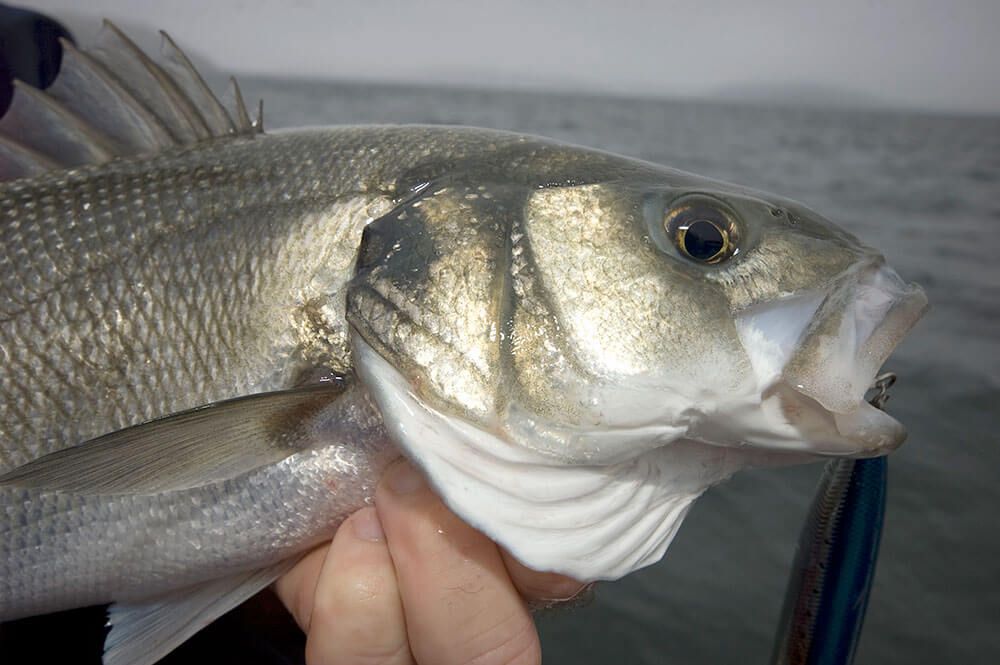
When fishing over wrecks and reefs 12/15lb class rods are the best choice. Choose a longer type about 8-feet in length with a fairly fast action and power in the middle section and butt to work fish back against a fast tide run, also to set the hook at long range. Match this to a modern lightweight low-profile reel such as an ABU REVO Toro Inshore or conventional multiplier such as a Penn 515 or Daiwa or Shimano equivalent reel. Load with 20lb braid and add a short 8-foot section of 20lb Fluorocarbon leader.
For uptide fishing a lighter 2-6oz uptide rod between 9-feet 6inches and 10-feet is perfect. Good reel choices are Penn 525Mag's due to their strong gearing. 15lb to 20lb mono and a shock leader complete the outfit.
For vertical jigging you need a 9-foot to 9-foot 6-inch spinning rod capable of casting up to 3ozs or so. A 040 size fixed spool, such as the Penn Slammer or Clash 4000 or Shimano and Daiwa equivalent, is perfect loaded with 15 to 20lb braid. Again, add the short 8-foot section of Fluorocarbon so the fish do not see the braid in clear water.
When working lures, the modern trend is to fish an 8ft to 9ft spinning rod and a 4000 sized reel loaded with 20lb braid, plus a short Fluorocarbon shock leader the same breaking strain as the main braid. This can be fished all day without fatigue, has the option to be cast longer distances, can be used over wrecks or inshore reefs, has the length to play fish that try to get under the boat, but equally has the power to target bigger fish in fast tides.
How to build a boat Whitby Lure rig
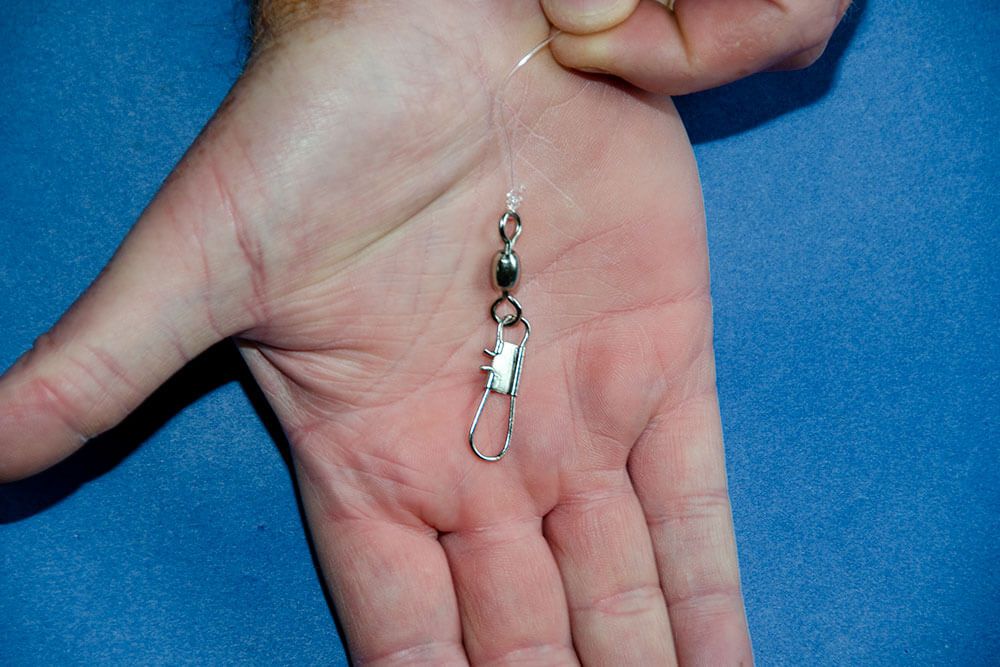
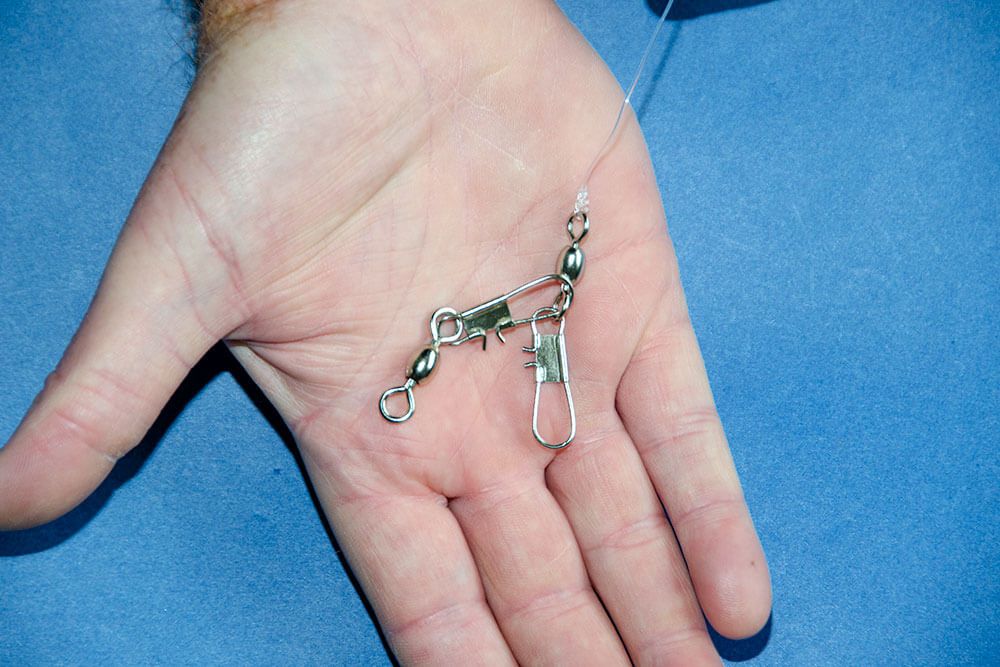
2. To this snap link swivel’s eye, snap on another snap link swivel by the snap link.
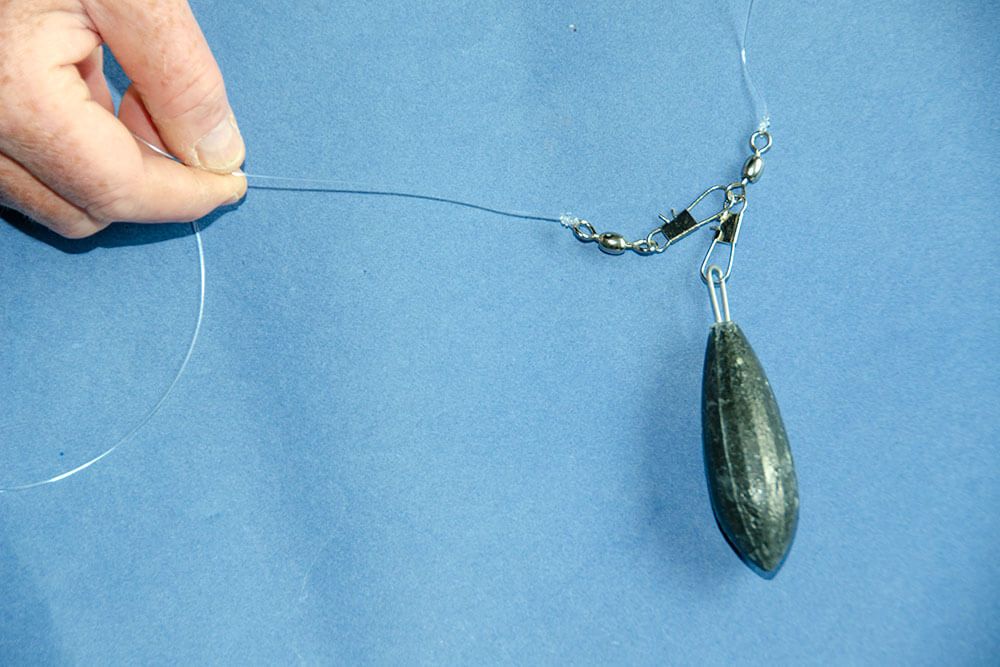
3. To the eye of this second snap link swivel tie on 5-feet of 40/60lb clear Fluorocarbon.
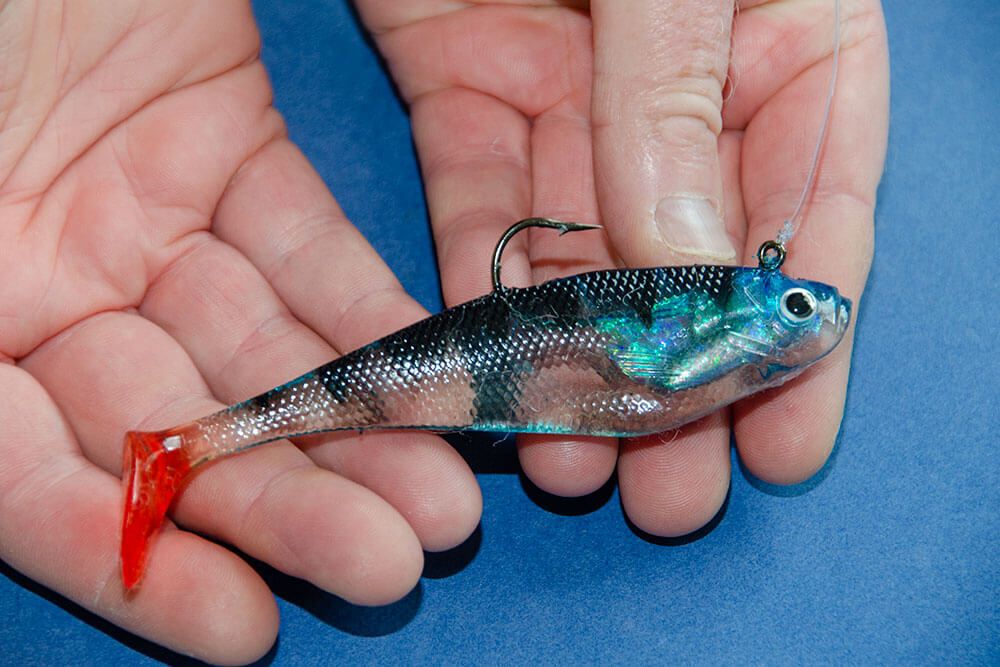
4. To the free end of the Fluorocarbon tie on the lure of your choice. Typically a weighted shad or sandeel such as a Sidewinder or Devils Own shad.
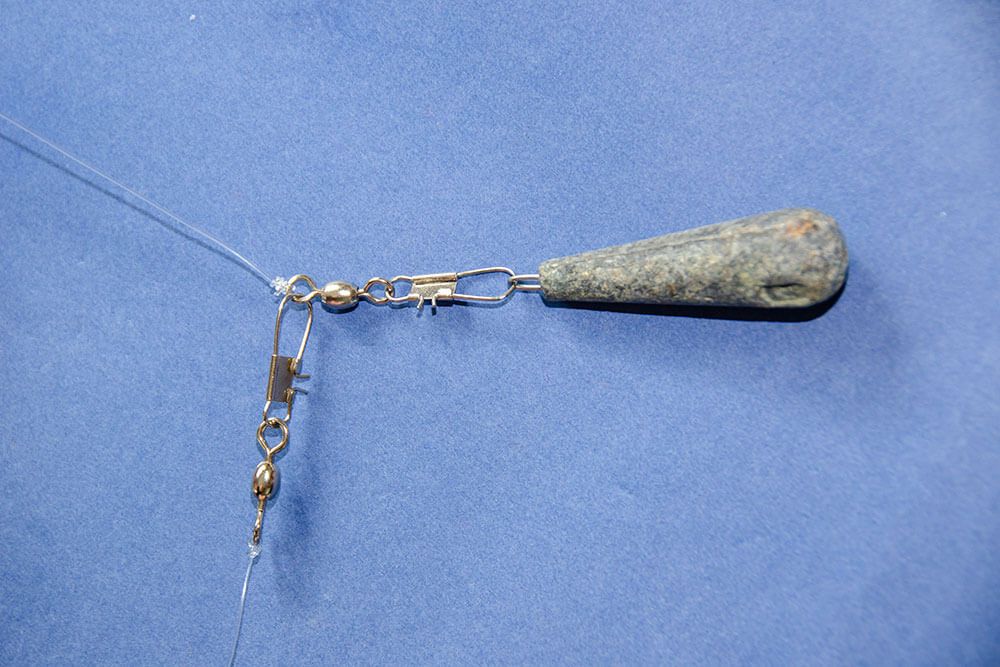
5. The lead weight is attached to the link on the snap link swivel tied direct to the leader.
This rig is virtually tangle free and requires minimal components when bass fishing over wrecks and reefs. It is ideal for fishing weighted shads and sandeel imitators and is also good for presenting fresh small live fish in a natural manner such as sandeel and mackerel. As you let the tackle descend to the seabed, when you feel the weight hit the bottom, instantly retrieve 2-feet more of line than the total length of your hook trace. Now begin a slow and steady retrieve.
Live sandeel is highly effective as bass bait when drift fishing and fishing at anchor in to reefs and wrecks. Live mackerel is also excellent in season.
The most consistent lures are artificial shads weighted shads in blue and natural colours just as the FIIISH Black Minnow, or the unweighted Berkley Ripple Shads in CC Special and Pearl Sparkle fished on the Whitby rig with a weighted hook.
Other good lures are Savage Gear Sandeels, Mr Twister and Powerworm grubs, Redgills, Eddystone eels, Sidewinders and Storm shads.
Spinning is also very effective with silver ABU Tobies in 28gm, also Dexter Wedge type spinners and anything that roughly represents a small fish or a sandeel being very effective.
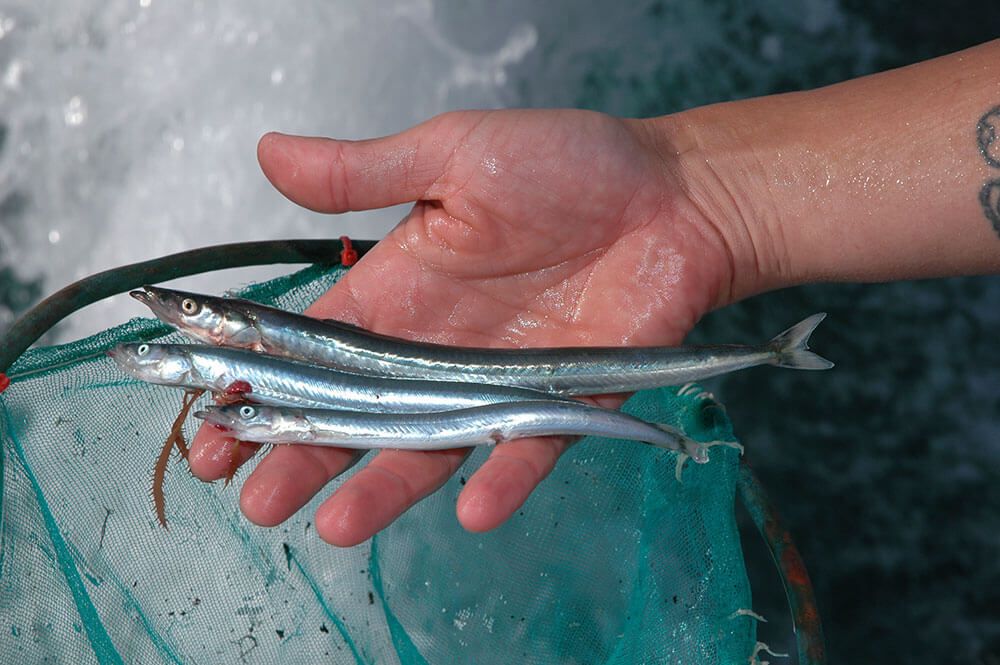
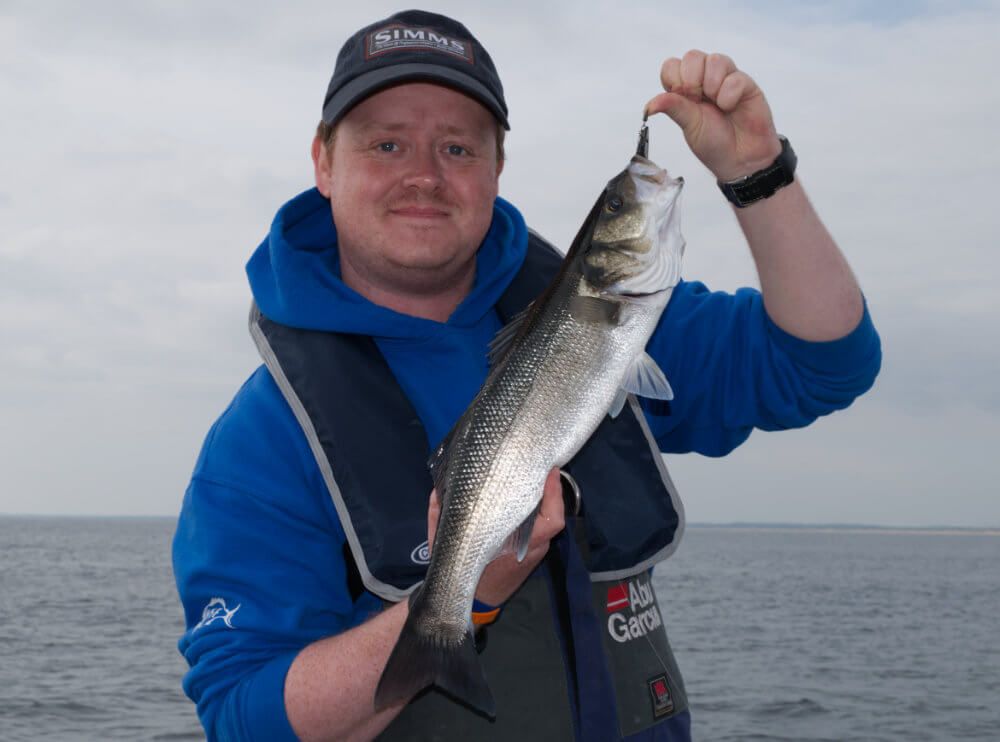
Talk trolling techniques from small boats and most anglers assume you're discussing foreign gamefish. Fewer anglers troll these days, but trolling lures is just as devastating this side of the pond as it is in warmer climes. Bass in particular, prove highly vulnerable to worked lures.
It's not localised sport either. Pick any part of the country where bass are caught and providing you locate suitable ground features, you're in with a chance.
This is the make or break of success, for often, the bass are concentrated in very tight areas and can go unnoticed by many anglers.
Begin considering ground very close inshore first. Look to the mouths of estuaries, immaterial of size, as potential holding ground. Ignore large areas of clean sand and even deeper clean ground gullies. You're looking for areas of mussel beds, patches of boulders scoured out by the fast estuary currents, weed beds, or sandbanks that cut deep into the main tidal flow creating a tide rip with a calm, deep bay on the inner estuary side. Sandeels, and then bass, congregate over the rough ground patches, but are not present on the clean sand.
The exception to the clean sand rule is the shallow sandbank that deflects the tide. Sandeels get swept into these and are picked off by bass that sit on the edge of the fast passing current just inside the quieter water on the downside of the sandbank.
Moving away from the estuaries, look to the rough ground beaches as your next test area. The place to try trolling is roundabout the low water line of a normal spring tide mark from mid tide up, depth depending. Ideal ground would be boulders, weed beds, small rocky peaks a few feet high that suffer some tidal run, or a definite drop-off area from very shallow to slightly deeper water.
The best marks of all are reefs, preferably shallow reefs, that are connected to the shore. If these run for any distance in an offshore direction, then at some time they will hold bass. What happens is that bass herd sandeels on to the top of the reef and hold them there by staying below and downtide of them. The bass, now shoaled up and numbering anything from a dozen fish to hundreds, make frequent raids into the panicking sandeels a few fish at a time. This activity can be clearly seen by frequent splashes on the surface as the bass seize a victim and turn, and by the hordes of screaming and diving terns taking advantage of the chaos.
In all these situations depth is not important from the bass's point of view. They will work around the mouths of estuaries and over inshore rough ground in only a few feet of water. The only criteria here is of boat and crew safety.
Over deep water reefs where you may have 30ft plus of water under the hull you are looking for the peaks of uplifting rock pinnacles. Again, the sandeels are worked towards the peak of these pinnacles with the bass below them.
To herd and trap the sandeel, bass need a wall to push them against. This wall is the flowing tide. Small neaps rarely give bass the opportunity. You need to concentrate on the middle to larger spring tides. The peak periods are just before, and just after the highest tides of that cycle.
Both high and low water periods, again because of little tidal flow, are poor. It's the middle hours of the flood and ebb that prove best, in particular the ebb which often produces the bulk of the fish.
Don't expect prolonged feeding bouts. These will only last an hour, maybe a little longer, then the bass move off.
Time of day also plays its part. Dawn and dusk periods are prime when working ground close to shore. It's less critical offshore, but mid-day is less reliable than when the sun's rays are at a shallower angle on the seas surface during mid-morning and mid-afternoon periods. Hazy days when the sun is subdued are excellent, but cloudy days are hit and miss depending on the clarity of the water. You do need a high degree of visibility for real success.
Tackle for bass trolling is simple. A 15lb class 8ft boat rod or lighter spinning blank about 8ft long, but with a stiffish action works well. Get a soft actioned blank and you struggle to set the hook properly in the bass's jaw when the line comes tight. Short boat rods of 7ft are just about acceptable but need to be fished from the stern only to keep the line away from other anglers, and on dinghies, the outboard motor. Longer rods keep the lines apart when several people are trolling on the same boat.
Reels need to be multipliers holding 250-300yds of 12 to 15lb line. Fixed spools are not suitable for this type of fishing as reel clutches need to be set precisely to give line the moment a fish hits the lure and turns.
Artificial sandeels such as Redgills and Eddystone's or similar will cover 90% of the fishing. Occasionally, the bass will be choosy and take nothing but 4ins eels, on the next tide they want the bigger 7in eels, rarely will they take eels larger than this.
Colour is also important. The primary taking colours are all white and all black, or a mix of red and black. However, sometimes the bass work in an eccentric manner and demand fluorescent orange, bright yellow, or luminous green. These occasions are rare but emphasise the need to carry a range of colours. Other good colours to try are all red, and combination coloured eels with pale bellies and darker backs.
To retain the action of the lure you require minimal weight to be added. For all shallow water fishing you nothing more than a single large swivel. Tie the main line to one eye of the swivel, and a length of 12 to 15lb line about 8ft long to the other, then the eel. In deep water you may need a spiral lead or bullet weight. The spiral is best having the best streamlined shape and are less conspicuous.
Other lures worth considering are the artificial fish with wagging tails like shads in the larger 6in sizes and Mr Twister lures between 4 and 6ins long. Again, vary the colours.
Spinners in chrome colouring like ABU Toby's, Dexter Wedges and any sandeel or fish look alike can work at times, usually during bright sunlight. Diving plugs can also be excellent, but colour comes in to play with silver and black the best.
Once you know and understand the ground composition you are looking for, the technique is easy. You start well uptide of the ground you wish to cover and to one side. Set the boat up to run at about 1 to 2 knots, no faster. Pick a line that sees the boat pass over the selected ground across, but at a slight downtide angle. This is essential to success. If the lure is trolled swimming slightly into the tide the bass will ignore the lure. The eel must swim slightly with the tide and across it. 1 to 1.5knots of speed is usually the optimum for taking bass, go faster and strikes fall away.
Marks that have little tidal run, areas of rock or mussel beds out in more open water, or ground just out from a rough ground beach, can be fished just by trolling in a line along them.
The lures need to be worked between 50 and 100yds behind the boat's stern. Stagger these distances so that each lure is at a different setting. After releasing the lure, hold the rod at right angles to the boat and keep the rod tip low to the water. As a fish takes, the tip simply gets heavier. Just lift the rod and the tightening line sets the hook.
As a fish is hooked it is policy to shout "Fish on", the helmsman should then shut off power and leave the boat to drift naturally with no forward movement while the fish is landed. Those anglers not into fish at this time should slowly retrieve their eels back towards the boat.
Any turns by the boat with lures still trolling can produce horrific tangles. It's up to the helmsman to take turns and course alterations very wide and slow. Use the tide to keep the lines to the lures tight, then push beyond and uptide of the ground dropping back to troll under power as before.
Trolling requires permanent vigilance. The helmsman always stays solely on the wheel . There are rocks out from rough ground beaches close to the surface, likewise on shallow reefs which should always be borne in mind.
About bass
Bass is a distinctive fish having two dorsal fins, the front carrying 8 to 9 sharp spines, and the body is covered in big scales. The colouration tends to be green-grey on the back, occasionally dark blue, shading to silver sides and a white belly. Some bass can also sport a dark spot on the gill cover. Only the black bream looks remotely like the bass, but the bream is far more oval, whereas the bass is a long round-bodied fish.
Bass range as far south as the Mediterranean and the North African coast, but also north to southern Norway. They are common throughout the southern half of the UK, over the past two decades they have extended their range along the east and west coasts of Scotland and are now caught in growing numbers as far north as Dunnet and occasionally from the beaches in the Orkney Islands. Bass are also commonly found along the southeast, southern and southwestern coasts of Ireland, and to a lesser extent along the north coast of Northern Ireland, though again their numbers have shown an increase, especially in Donegal.
Bass, referred to by the French as "Loup de Mer" meaning the Wolf of the Sea due to their prowess as a hunter, have a wide-ranging diet taking crabs, shellfish, shrimps, sandeels, worms. Bass will also feed on a wide variety of fish such as mackerel, gobies, blennies, pouting, poor cod, rockling, sprat, squid. Bass will often scavenge human food waste inside harbours such as bacon and chicken bones that have been thrown over the side of boats.
Their breeding season is from late February through to late May. This occurs mainly in deeper water offshore between January and March. However, some knowledgeable bass anglers have witnessed large adult bass behaving in a breeding manner in shallow water at the heads of estuaries in the mid May period. This indicates we may not know all we think we do when it comes to bass breeding habits.
Shore Fishing for Surf Bass
When and where to fish for surf bass
Bass can be caught throughout the year south of a line drawn roughly between Cumbria and North Yorkshire, but in the far north of Scotland, the season tends to be late June through to late October, generally speaking. In southern Ireland, bass again can be caught all year round, especially in Wexford, Cork and Kerry, but in the north, the season is shortened to mid-June through to late October.
However, due to changing seasonal weather patterns around the UK, resulting in milder winters generally, bass can sometimes stay inshore and feeding right through to Christmas. This also seems to be when there is a definite increase in the chances of a bigger 10lb plus fish being caught. This though has always been the case in the west of Ireland, where traditionally, some of the best bass fishing was either side of Christmas, especially on the Kerry beaches. Though the overall numbers were down, the average size of fish was bigger.

Tides are vitally important! Bass tend to work a surf beach from low water and for the first two hours of the new flood, then typically disappear for the middle hours of the flood but return for the final hour before high water and sometimes stay for the first hour of the ebb. This is a general rule, not always fact, with some beaches being devoid of bass on the flood but fishing well on the ebb. This scenario often occurs when an estuary flanks the beach. Bass run the estuary on the flood tide, but as they leave the estuary as the tide begins to flow out, they drop back down the length of the beach with the ebbing tide.
Shallow Surf Beaches
The best of the surf bass beaches tend to be shallow, often cut with parallel deeper gutters, and will fully or partially face the prevailing winds. Ideal surf conditions, typically produced by steady force two to force five onshore winds, tend to be when the surf tables are wide, not when the surf is short and breaking close together. That said, huge surfs generated by a series of strong onshore winds can still produce fish. Bass is a powerful fish and can cope with what looks to the angler like impossible seas. Those that persevere through these tough conditions can sometimes be rewarded by good catches providing they have the casting ability to reach the deeper water.
In a good surf and coloured water, bass can be caught in daylight, but generally, the best of the fishing will be in the hours of darkness. If possible, try to choose tides that begin to flood fully in the dark. Such conditions induce the highest numbers of fish inshore. Tides that flood in daylight can see reduced numbers of fish, especially if the water is clear. Peak times for feeding are when low water coincides with dusk or dawn.
If you have no choice but to fish a daylight tide, then the best conditions are when there is good cloud cover to subdue the light levels entering the shallow water. Bright sunshine on surf beaches is rarely good. If the day is bright, then try to seek out deeper water where the light levels are less intrusive!
Fish holding feature is the key to finding the fish on surf beaches. Feature will be deeper gutters that typically run parallel or at angles along the length of the beach. These are created by tidal current and by the turning over of the waves where they meet shallow banks and cause a backflow as the previous wave recedes. These gutters can be formed from clean sand, but some may have small stones or pebbles in the bottom. As the waves push forward, any displaced food items get washed into the gutters and stay there. Bass know this and will run these gutters with the flood tide but facing directly into the tide so they can pick up the waterborne scent from any food items. Also good are obvious depressions in the sand where the tide has scoured out shallow holes. Again, food gets deposited here, and these can often be seen by looking for areas where water holds after the tide has dropped back. Many people think bass hunt swimming with the tide, but the reality is the opposite. Bass usually swim into the tide, often pausing to maintain station and "sniff" the water for food scent, sometimes dropping backwards short distances while still facing the current.
Other surf beach features to look out for are areas of small stone or boulders. These again catch and hold food, as well as offer shelter to small fish crabs and other crustaceans. These areas will always see bass quarter them thoroughly at the appropriate stage of the tide. Areas of small weed growth will also draw fish, as will areas where there are a series of scoured out holes in the sand. The latter is where sandeels often bury in the sand, and the bass will hunt these here. Single big boulders are another spot where a bait is more likely to be taken. Even small almost inconsequential things like old wooden stakes buried upright in the sand that nets may have been staked to will pull bass as they see scoured out areas around their base that crabs and shrimp will hide in.
Something else to take note of is the high tide line, especially on beaches backed by shingle banks. If you look closely, you'll identify areas where there is far more waterborne debris such as wood and plastic washed up than in other areas. This indicates where a tidal-current washes inshore and on the shingle bank and bass will use these flows of current to search for food out in the deeper water.
There's an old saying that the bass are behind the third breaker, but this generally is not always true. One reason for this is that that is often as far as the average angler can cast so most of the fish will come from that distance. Bass though can literally be at your feet or 150-yards plus out. Typically, though, in ideal surf conditions and depending on depth, the bass will be from 20-yards to 80-yards out, but often working a precise band of water a set distance offshore. This will change as water depth deepens and shallows as the tide floods in. Therefore very successful bass anglers do not cast a set distance every time. If your first two casts to say 80yds do not produce, then start dropping each subsequent cast 10yds less each time until you find the fish. If this doesn't work, then cast as far as you possibly can. Wading as far as is sensible and then casting as far as possible, can often be the tactic that finds a fish on a day when few fish are feeding.
In really rough seas big bass may again be very close in amongst the breakers if the water is a good 5 to 6-feet of constant depth but are more likely to be 100-yards or more out in deeper water on shallower surf beaches where the undertow from the surf pulls food back out as it's disturbed from the sand.
Steep-to Beaches
A steep-to beach is one where the water is much deeper with a high rising shingle bank at the high-water level. The shingle will usually extend below the average low water line, too.
These will fish better in daylight than shallower water, but their wave configuration will typically be one or two breaking waves only. Food gets washed in from further out and then gets lodged at the base of the hidden low water shingle. This is the place to target bass which will run the junction of shingle and sand. This may only require a short cast between 40 and 60-yards but can be highly effective.
On these deeper beaches, often the ground is relatively clean, but there will be areas further out where fish may collect. These will typically be areas of sandbanks or again deeper gutters that form where tidal currents run. If you stand on the shingle and look at the surface water, note any area where there is confused or troubled water where small waves break. This indicates areas on the seabed that are different than the flowing tides passes over, creating a surface disturbance. Remember these will show on the surface downtide of where their actual seabed position is depending on how fast the tide flow is. You need to walk uptide maybe 50 to 100yds until you find the actual seabed feature.
Steep-to beaches can also fish very well for bass immediately after a storm when the sea remains rough, but the wind has dropped. This is when all the washed-out shellfish such as queen cockle, mussel, also lugworms, get washed into that low water line.
Tackle for surf bass fishing
An ideal shallow surf bass rod would be rated 2 to 4oz and be between 11ft 6ins and 11ft 9ins in length. This is an ideal length and light enough to hold for long periods when feeling for bites. The action needs to be a semi supple tip, but with quickening power in the upper mid-section to give good casting range with light leads, but also to drive hooks home at long range into the hard bony mouth of a bass.

Top reels to go with this type of rod would be smaller multipliers such as the ABU 6500 series, which have been a classic surf bass reel for several decades now due to their casting ability with lighter leads. Other companies such as Tronixpro, Daiwa and Akios do similar reels. If you prefer the simplicity of a fixed spool reel, look at reels in sizes 5500 or 060 sizes holding around 250 to 300-yards of 15lb line. Good examples are the Penn range including the Slammer, Spinfisher and Clash, also reels of similar design from Shimano, Daiwa and other companies.
You can fish with 15lb line and a 30lb to 40lb shock leader. However, if you can fish with a 2oz to 2.5oz lead, then 20lb mainline straight through will be enough without a shock leader to take the force of casting, even to longish range. In shallow clear water, heavier shock leaders can put some fish off, so where possible eliminate them, providing it is safe to do so.
Lead weights will typically be 2ozs to 4ozs and should be grip wires in normal surf conditions. You can use a plain lead and let the tide wash this around in a semi-circle back to shore to cover more ground but choose a lead heavy enough to only slowly move across the sand by tidal pressure on the line.
For heavy surf conditions, or when fishing deeper steep-to beaches, then a standard beachcaster between 12ft and 13ft and rated to cast up to 6ozs will be needed. Match this to a heavier duty multiplier such as the PENN 525Mag 3, or a similar reel.
The alternative more heavy-duty outfit is to go for a European style rod between 14 and 15ft, combined with a 7000 or 8000 sized fixed spool reel and load with 30lb braid and use a 60lb braid shock leader knotted using two Grinner knots back to back. This forms a relatively small knot that flies through the rod rings easily and proves better than mono in most circumstances.
Due to their extra length, these longer rods increase the speed of the lead weight, which in turn increases casting distance.
How to build a surf bass fishing rig

1 - Begin with about 30-inches of clear mono. To one end tie on a Gemini lead link.

2 - Slide on a Breakaway Impact Shield followed by a 3mm bead and a rig crimp. Crimp the Shield in place 2-inches above the lead link.

3 - Now slide on a rig crimp, a 3mm bead, a size 10 rolling swivel, another bead and a crimp. Leave these loose for now.

4 - To the free end of the 60lb line tie on a size 4 rolling swivel.

5 - To the hook trace swivel tie on 20-inches of 30lb Fluorocarbon line, alternatively clear mono. To the end slide on a 5mm bead and add a single size 2/0 Mustad Viking 79515 hook.

6 - Position the Impact Shield just above the lead link and put the hook inside the clip of the lead link. Slide the hook trace swivel and crimp assembly up the rig body line until the hook trace comes just tight and crimp the trace swivel in place.

7 - Above the 5mm bead tie on a stop knot from 14lb Powergum to act as a bait stop.
Follow our guide on how to build a surf bass fishing rig in our sea fishing rigs section.
Baits for surf bass fishing
Lugworm, either blow or black lug, would be the most consistent bass bait in the surf. Ragworm also works but is never as reliable in the surf as lug is. When baiting with lug, always nip the sandy tail off a short way below the body, then slide the worm, tail end first, over the hook point and around and up the shank of the hook. This puts the fat juice-filled head of the lug's body at the hook point.

Sandeel is another good surf bait for bass, either used as whole small sandeel with the head and tail cut off and simply threaded over and up the hook, then bound with bait elastic for security. Alternatively, use 3-inch sections of larger sandeel like launce, and again use bait elastic for security on the hook.
Peeler crab can be a good surf bait if you're fishing close to the rougher ground. It seems less effective over clean sand. The best presentation is to use crabs about the size of a 50p piece, remove all the body shell, cut the bait halfway into the body, then thread the body around the hook shank then secure with bait elastic to form a rough sausage shape.

After storms, razorfish can be deadly, as can queen cockles, and in the autumn period, bigger bass will also take mackerel heads simply hooked through the two jaws or between the eyes, whole squid and half body sections of bluey. Again, bind these baits well with bait elastic for improved casting strength.
Top 6 Tips for Bass Surf Fishing
- Study the shape of the surf before starting to fish. Look for areas where the surf breaks closer in compared to the surf at each side of this. This indicates an area of deeper water where food will collect, and the fish will visit as they travel with the surf.
- In heavy surf conditions look for areas where the surf tables are longest in between the breakers. Here the water is steadier and more predictable, and again the bass will work this area thoroughly before moving on.
- You hit more bass bites if you hold the rod all the time and feel for bites to gain a quicker reaction time. Face the sea slightly sideways on and hold the rod across the body with the rod tip parallel to the surf with the tip pointing slightly down and the line tight to the lead.
- Bass take a bait in the surf when swimming forwards. The bite will typically be a sudden hard pull down on the rod tip as the fish pulls the grip lead free from the sand. As this happens instantly hit the fish back by rapidly lifting the rod tip in a high upwards arc away from the direct line to the fish to sink the hook.
- Fluorocarbon is the better hook trace material, even at night, as it is slightly stiffer than monofilament of the same breaking strain and tangles less in the surf. In daylight, it's also less visible than the mono when fishing in shallow calmer water.
- Don't make your baits too big. Use two small to medium-sized blow lug up the hook, then lay another lug underneath these and whip the lot together with bait elastic to form a small thick sausage shape that oozes juices. This is plenty big enough to take big bass but can also be cast to maximum distance with a lighter 2oz to 3oz lead when necessary.
Shore fishing for rough ground bass

When and where to fish for rough ground bass
Big bass can show up anywhere, but good areas are the North Foreland of Kent, the Sussex coast, rough ground in Devon and Cornwall, the Bristol Channel, and especially the west coast of Wales. Of late, Luce Bay has also produced some bigger fish from the rougher ground. The Wexford, Cork and Kerry coasts of Ireland are also a rough ground bass mecca.
The season starts at the beginning of April and coincides with the first real flush of the peeling crab. Bass numbers improve through May, then peak in late June just as the crab peel starts to wane. Although some bass will always be present on rough ground beaches, especially during rough seas, their numbers drop dramatically in July through to mid-August when the crab peel in fewer numbers, also the bass tend to move out onto offshore reefs and target small fish such as sandeel and joey mackerel. They come back on to the rough ground in late August and feed there until Christmas in milder years, with crab again the primary food source alongside fish.
Generally speaking, bass on rough ground prefer the bigger sized spring tides. The peak tides are those the three days before the very biggest tide. Fish can still be caught on the dropping tides after the highest spring, but overall numbers of fish will decrease as each dropping tide passes.
Low water is a good time, especially if it coincides with dusk or dawn, but the bass tend to work a rough ground beach for the first two hours or so of the flood, then move elsewhere, returning for the hour either side of high water. Darkness is always good as the fish feel safer when working very tight to dry land.
Ideal weather in daylight is an overcast day with a light force two to force four wind straight in off the sea. That said, calm conditions can also surprise with the odd fish. Rough seas can be very good, but generally, you'll need to cast further to find the fish.
The best rough ground bass anglers develop the ability to read the beach and to see where the bass will work looking for food. At low water, look for small finger reefs that run inwards up the beach. These are natural edges that will trap food as the tide floods in. Also, look for areas where bigger, heavier stone sits amongst smaller stone. This rougher ground traps more food and has more hidey holes for crabs and small fish to live in. Also note depressions in the stones that hold water as these too, will trap food. Another hotspot is a much bigger than average boulder. These often have depressions dug out by the tide around them and again collect food. At high water, do not be afraid to fish just 10 to 20-yards out from the high-water line. If you keep quiet and out of sight, bass will be almost at your feet.

Tackle for rough ground bass fishing
Rods are the same 2oz to 4oz rods used for surf fishing and need to be between 11ft 6ins and 11ft 9ins ideally. Choose one with a semi supple tip so that you don't smash soft crab baits during the cast, but with rapidly increasing power in the mid-section and a stiff butt so that you have the power in the upper mid-section and butt to bully big fish away from potential snags.
Good reels are the ABU 6500 range and similar loaded with 20 to 25lb line, or in extreme cases the Penn 525 carrying 25 to 30lb line. You will not be fishing at long range over rough ground with most casts being less than 50yds, so these reels can carry more than enough line in these higher breaking strains. Alternatively, use a 5000 to 5500 sized fixed spool reel again loading with 20lb mono main line.
Some anglers like to use a heavier 40lb braid on the fixed spool reel, as the braid does not stretch and gives slightly better bite detection, but what they forget is that if you feel the bass, the bass feels you and braid can result in dropped baits when fishing at close range.
Another option, and often a good one, is to use a Fluorocarbon mainline. This has the advantage of being less stretchy than mono, so improves bite detection, but also is less visible to a fish working in clear shallow water. It is also more abrasion resistant than mono when encountering boulders, barnacles and stones.
There is no need for a shock leader when using lines over 20lbs as the lead weights used will be less than 3ozs typically and you're not power casting. If you do need longer range to reach rough ground, then add a 30 or 40lb leader for leads up to 4ozs and increase the line used to make the rig line to the lead weight appropriately.
How to make a rough ground bass rig

1 - On to the mainline, slide on a Pulley Rig bead, then a 5mm black bead.

2 - To the end of the mainline tie on a size 6 swivel. To the end of the tied swivel add an 8-inch to 15-inch length of 20lb Fluorocarbon.

4 - The best hook is a Mustad Viking 79515 size 4/0. Tie this to the short section of 20lb Fluoro carbon.
5 - To the eye of the Pulley Rig Bead tie on an 18-inch length of weaker 18 to 25lb line depending on mainline strength to take the weight. This needs to be a dark colour to match the seabed when fishing in daylight. You can use a small link to attach the weight, but most anglers save tackle and just tie the weight to the line as losses will be heavy when fishing into the rough ground, plus you’re casting minimal distance usually.
Follow our guide on how to make a rough ground bass rig in our sea fishing rigs section.
Baits for rough ground bass fishing
Crab is the number one bait over rough ground as it is exactly what the bass are looking for. They will also take mussel, again a natural bait over this type of ground.
The usual baits such as lugworm, squid, ragworm and even razorfish will work, but are never as good as crab for overall numbers of fish caught.
How to make a peeler crab bass bait

1 - Pinch the crab between the eyes to kill it, remove the legs and claws and peel off all the brittle shell to leave just the soft body.

2 - Use scissors to cut half way in to the body from the middle front of the crab.

3 - Holding the hook in your left hand, starting with one side of the cut body slide the bait over the hook point and round the bend of the hook and up the shank. If the crab is not big enough to fully fill the hook, add another half or whole body.

4 - Use bait elastic sparingly to form a rough sausage shape but with lots of juices still able to leak out of the crab body for maximum effect in the tide run.

Rough Ground Bass Bites
You would expect a typical rough ground bass bite to be a savage rod wrenching affair. This can happen, but there are many types of rough ground bass bite.
Bass are often shy biters on rough ground and often you'll feel a light tap on the rod tip as the bass blows the crab in and out of its mouth almost testing it. This is followed by a pull-down on the rod tip, which needs to be struck.
Sometimes bass will just move the lead weight and you can feel it slide on the stone. Don't confuse this with the surf or tide, but if unsure, strike anyway!
You will also feel the pressure on the line fall slack. This is a bass swimming in towards you after taking the bait. Wind down hard on the fish retrieving line on the reel and when you feel the full weight of the fish, strike!
If you always hold the rod, you'll get to recognise the full variety of bass bites, but more so, develop a sixth sense that enables you to "feel" that something is happening, even when there is no obvious movement on the rod tip or obvious bite.

Top 10 Rough Ground Bass Fishing Tips
- The best times to fish are the last half hour of the ebb, and especially the first hour to two hours of the new flood tide. Many bass beaches then go quiet, until the hour before high water and the first hour after high water. These are key times on bass beaches throughout the UK and Ireland, but all beaches fish differently, so use these key times as a basic guide, then experiment outside these times on your selected beaches to find the optimum feeding periods.
- It pays to look at the ground you will be fishing on a big spring tide low water. Look for deeper gullies running in towards the beach from the low tide line, areas where the rocks have created small miniature reefs running along the beach and fish the seaward side of these, but especially fish tight into big rocks and boulders that sit amongst generally small boulders. Pay attention to any depressions or scooped out areas that hold static water when the tide has receded amongst the rocks and boulders. These areas are often tiny, just a few feet or yards across, but they hold food washed down by the tide and are hotspots for bass to feed. Also, check out areas where sand patches are mixed in with rocks and rough ground.
- In calm clear seas stand back from the water a little, or better still, use a big boulder to stand behind. Bass will literally feed with a few feet of the tide line over rough ground and it's common to see their tails break surface as they invert to dig a crab or small fish out of the boulders with their nose and by sucking water and food into their mouths like a suction pump. The best conditions over rough ground are a slightly rough sea or a sea fining down after a strong blow. Bass are powerful fish and if you can keep a bait static on the seabed and contend with the weed in these rough conditions, then you'll often be rewarded with a good bass. Also don't keep walking about on the shingle as noise will push close in bass back out to deeper water. This cannot be emphasised enough!
- Rough ground bass can be nervous of water less than 6ft deep in daylight, less so if the water carries some colour. However, as with many forms of fishing, bass will feed best over rough ground through the dark hours in shallowish water.
- You need to hold your rod all the time you have bait in the water. Bass bite quick and are adept at dropping baits without getting hooked. The best stance is to face the water but cradle the rod in the hands with the leading arm extended at an angle to one side and the other hand on the butt. This allows for a quick upward sweep of the arms in conjunction with a backward rotation of the upper torso to quickly tighten the line and set the hook in to a very hard mouth. This is another reason why soft rods do not work for bass; they limit line pressure to the hook and absorb too much of the physical strike resulting in fewer hooked fish. When holding the rod, use just enough rod pressure to tighten the line to the lead, but without moving the lead.
- Use only enough lead weight to carry the crab to where you need it to go. Top rough ground bass anglers will use leads from just ¾oz up to 2ozs, rarely more than 3ozs. Smaller weights snag less and spook the bass less if they drag them a few inches over the ground as they pick up the bait.
- Soft crab can be just as effective as peeler crab, but use them whole, even big crab, as the bass will smash a soft crab to bits as it crunches down it in its mouth and easily find the hook. On beaches where velvet swimmer soft crab and peelers can be found, a velvet swimmer softie can often be the "hot" bait at the peak time you expect the bass to come through. Edible soft crab is also a top bass bait but remember these need to be in size according to commercial regulations applicable to your area.
- Keep your tackle to a minimum. Bass move all the time often giving you just 10 minutes and one cast before you need to move again to keep in contact with the fish. Carry one small rig wallet with a dozen rigs in, bait elastic, scissors and a honing stone, spare hooks and spare leads. You bait needs to be in a small plastic bucket or better still in a container around your neck so you are fully mobile and have access to fresh bait without moving about to create noise.
- Top bass anglers rarely use mono for their hook lengths nowadays for several reasons. Mono can create little light flashes under water as it moves due to wave action and catches the light. This can be enough to spook shy bass working in shallow water. It is also easily abraded and just a single nick in the surface can severely weaken it. Mono also stretches more and can forewarn delicate biting bass that something is amiss as it picks up the bait. Using Fluorocarbon has several advantages. Firstly, it is less likely to be seen by the bass. Secondly it has a higher abrasion resistance than mono, so can cope with minor contact with barnacles and rocks better. It also has minimal stretch so gives better bite detection as a fish picks up the bait, plus helps maintain strike power at the hook point. The use of a Fluorocarbon mainline can also be considered for the same advantages.
- Dull off the shine of any newly moulded leads by soaking them in vinegar for a few hours before fishing. Also use brass or galvanized eyes, not stainless wire eyes as these can reflect light in shallow seas. Bass have incredible eyesight and will pick up on foreign objects that stand out from the general seabed when in close proximity to baits.
Shore fishing for estuary bass

Where and when to fish for estuary bass
School bass can be caught throughout the year, these being bass up to about 2lbs in weight or so, but adult bass fresh from spawning show first towards the end of March in the south, but more likely in the middle of April in Wales and off Essex, and then on the East Anglian coast by the end of April or beginning of May. Further north it's usually late May on that sees the fish really worth fishing for. They stay until October in the north but can linger as late as Christmas in the south.
Early in the spring, until about mid-June, it's the presence of peeling shore crab that brings the bass in to the estuary. The crab is a reliable food supply and it's no surprise that once the crab start to show, it's only a couple of weeks before the bass are in and their numbers building quickly. By mid-May the bass will also be actively hunting sandeels, also the small sea trout, mini species and small flatfish as their numbers build.
The best tides are the building middle sized tides through to the very biggest spring tides. As soon as the spring tides start to drop back, bass numbers will also ease away. Bass can be caught on smaller neap tides too, but the numbers running the estuaries are usually much less and the likelihood of bigger fish is more remote.
Although bass will work the estuaries in calm, warm conditions, it's in the roughest weather that the bigger bass are more likely. During gales some big bass will come to feed inside the smaller estuaries. Bass will also tolerate some freshwater from the hills but will not stay inside the estuaries if the water is very acidic after major rainfall and flooding.
Day light fishing can be productive, but generally it's at night that the best of the fishing is enjoyed. Especially when low water falls in the dark and the bass move confidently into the estuaries.
Bass wait in numbers at the mouth or bar of our smaller estuaries and will move in as soon as the new tide starts to push. They use the tide to help them travel miles inland. Initially they travel through the main channel working seed mussel beds and any patches of rocky ground. They will quarter around small jetties, piers, harbour walls, breakwaters, and through small harbours. They move into the drainage channels drawing water off the salt marshes targeting crab, small fish and sandeel, but also work through weed and muddy boulder ground sniffing out crabs and small fish.
Another good spot is where a smaller estuary bottlenecks and narrows forming a fast moving current. Bass use this fast running tide to push sandeel shoals up against and make them easier to pick off.
Bass can still be caught on the ebb tide as they run out of the estuary, but they are cautious of being cut off and tend to work the edges of the deeper main channel as they drop back, and especially like areas where surf is evident as it breaks over shallowing sandbanks on the seaward side.

Estuary bass tackle
For general fishing for bass a 1-3oz or 2-4oz Bass rod about 11'6" is perfect matched to a light 5000 sized fixed spool reel such as the Penn Slammer or Clash, or a similar Shimano or Daiwa reel. Line strength needs be no more than 12 to 15lbs, though some anglers prefer to load with 20lb braid.
Anglers fishing rough weather and in estuaries where the tide run is fast with maybe some floating weed and with big fish in mind, they would choose the 2-4oz bass rod, again 11'6" in length, married to either a 6000 sized fixed spool reel or a small multiplier such as one from the ABU 6500 series, with Penn 515's also popular. Line strength would be 15lbs, possibly up to 20lbs if fishing in amongst snags.
For any casting also add a shock leader. These should be 30lbs for leads up to 3ozs, and 40lbs for leads up to 4ozs. Always use a clear leader for daylight bassing as bass can shy away from bright colours. Fluorocarbon is a better leader material than mono for this as it is more abrasion resistant and less visible to the fish.
How to build an estuary bass rig

1 - On to your leader slide on a size 6 rolling swivel followed by a black size 5mm plastic bead.

2 - To the end of the shock leader tie on another size 6 rolling swivel. To the sliding swivel tie on 24-inches of 30lb to 40lb Fluorocarbon.

3 - To the end of the Fluorocarbon tie on a Gemini Lead Link to take the weight.

4 - To the end of the swivel tied to the shock leader, tie on 15-inches of 20/25lb Fluorocarbon or clear mono to form the hook length.

6. To the end of the hook length tie on a size 4/0 Mustad Viking 79515 hook, or similar Viking type pattern from Sakuma or Varivas.
This rig gives excellent rod tip and hand felt bite detection as the hook and main line are pull in the same direction, but also it maximises the power of the strike directly to the hook. That said, with the sliding swivel, a cautious bass can be allowed to pull line freely through the sliding swivel without fully feeling the lead weight. Fish as light as you sensibly can, and you will catch more bass as a result!
Follow our guide on how to build an estuary bass fishing rig in our sea fishing rigs section.
Baits for estuary bass
As we've already seen, from late March through to June fresh peeler or soft crab will be the magic bait for estuary feeding bass. However, from mid-May onwards, and especially from mid-June when the crab peel falls away, the bass will move on to a fresh fish diet targeting sandeels and smaller fish. Worm baits generally, tend to catch the smaller fish.
To bait with peeler crab, first fully peel a dead but fresh 50p sized peeler crab, then cut the body in half. Push the two halves up on to the shank and bend of the hook leaving only the hook point clear of the bait, then bind the bait to the hook with some good tight turns of bait elastic. Big bass will hit big baits, but baits above the size of a standard small matchbox will see your bites ratio reduce.
Frozen sandeel is a good estuary bait. Simply pass a long-shanked hook down through the mouth and out through the gill, then stitch it twice more in and out of the body to leave the hook point clear about halfway down. Add a few turns of bait elastic around the head for casting security.
Later in the season and into Autumn, a fillet of mackerel or bluey, whole squid, soft or peeler crab, also big worm baits will take bass as they feed up for winter. Another good estuary bait, especially after an autumnal storm is razorfish and mussel.

Top 5 Tips for Estuary Bass Fishing
- When fishing big baits in the autumn for the bigger fish, change to a running ledger rig. Have a Zip Slider boom and a 5mm bead running free on the leader, tie on a size 4 rolling swivel, and to the other end of the swivel add 24-inches of 30lb clear mono or Fluorocarbon. You can use two hooks rigged pennel style, but a single big 4/0 or 6/0 Viking pattern is just as good!
- When fishing right into the margins where rocks and weeds form the edges of the main channel, even at night keep out of sight and be prepared to fish baits at just five yards, as this is where the bass will be. This is especially true when fishing smaller side creeks off the main channel.
- A simple way to target bass feeding on sandeels, such as when right up against a tide run where the estuary narrows, is to attach a clear bubble float to the mainline and add about 4 to 6-feet of clear 15lb mono or Fluorocarbon and a size 1 Kamasan Aberdeen hook. Flick the sandeel out in to the current and let the float bring the sandeel to the bass. It's deadly!
- At the heads of smaller estuaries look for areas where patches of boulders and shingle run up against clean sand. Bass will work the edges of the clean sand as this is where food washes up and gets lodged in amongst the stones.
- Casting crab into narrow drainage channels at night can produce some big bass. The bass cruise up these on the flooding tide but will drop back as soon as the high tide peaks. Drop the bait at the edges of the inclines of the bank, not out in open water.
Freeline fishing for bass
A forgotten bass tactic is pure and simple freelining. It's not commonly used even by experienced bass anglers and yet it is the most effective form of fishing at close range over rough ground or in shallower estuary side creeks and around weed banks.
The phrase some carp men use when stalking carp working tight into the margins is "combat fishing" and this is the perfect description and it applies just as much to close quarter bassing with freelined baits.
Experienced bass anglers will tell you they can often be stood on the tide line and watch bass just a few feet away from them working through the boulders, dorsal or tail fin right out of the water, oblivious to the angler nearby. These are the fish you target with freelined baits.
When and where to freeline for bass
Freelining really comes in to its own from mid-April through to late June, then again from mid-August to late October when the crab are peeling in good numbers and the bass run through the rocks and boulders pretty much every tide. At this time, during the first hour of the flood and the hour either side of high water, bass will work very close into the tide line, often in just a couple of feet of water.
The best tides will be the bigger spring tides. Always the best fishing will be on the tides that fall in the three days prior to the biggest tide of all. This is when the largest numbers of bass move inshore to feed. Immediately the tides start to fall back towards neaps the numbers of bass fall inshore and you're fishing to a much reduced audience.
Dusk and dawn, as ever, are great times to be fishing, especially if it coincides with low or high water. Equally fishing a low or high tide in full darkness can also be very effective under the light of a light sky or moon.
Never rule out full daylight, but ideally you need to be fishing on the more overcast days, better still if it's drizzling or raining, the water carries just a hint of colour and a light breeze roughens up the seas surface to inhibit light penetration. In short, it's less easy for the bass to see you!
Hot spots for bass are areas where the smaller boulders are broken up by any bigger boulders as this will hold the crabs better. Perfect spots are depressions in the boulders that hold water when the tide has receded, and you should make special note of where these are for when the tide floods in. Any food pushed along by the tide gets dropped in here and the bass will always work these holes.
Other good spots are the deeper edges of shallow rising finger reefs running shoreward, small patches of sand amongst rough ground and areas of weed.
Freelining also works when casting along the edges of weed covered estuary sides and into shallow drainage creeks, again during the flooding tide.

Tackle for freeline fishing
Tackle is kept very simple. Choose either a 9ft 6in spinning rod capable of casting up to 3ozs or go for a full 2-4oz bass rod, but make sure the latter is a very light example as you will be holding it all the time.
The only reel for consideration is a fixed spool reel. An 040 to 050 size is ideal and light in weight. Choose a model with a good front drag system such as the Penn Slammer 4000, Penn Clash 4000, or equivalent Shimano or Daiwa.
The big debate is mono or braid line? Braid is often preferred for a couple of reasons. Firstly, you're literally feeling for bites from fish that might be just 10ft away. The braid line is so sensitive that when your instincts become fully attuned to freeline fishing you'll sense the fish close to the bait before you feel the bite proper. You might not believe this...but don't doubt this until you've experienced it for yourself. Also, the braid catches the tide less and gives a more direct pull of power to the hook point when striking for such close quarter reactive fishing.
When fishing braid, choose a soft supple type such as the Berkley X9 in 20lb or 30lb breaking strains depending on the severity of the ground you're fishing. It always pays to add a short 5ft section of 20lb Fluorocarbon line to minimise visual contact between the braid and the fish but also to just give a hint of elasticity when playing big fish right under the rod tip.
Mono is okay though, but I'd suggest using one of the better quality Fluorocarbon reel lines in 20lb such as the Berkley Trilene as it's less easy for the fish to see at such close range.
There is only one hook to really trust, the Mustad Viking 79515. These have a knife-edge point and can be honed to maximum sharpness easily. The size 4/0 is ideal for big crab baits but choose the size of the hook to suit the size of the bait.

Keep tackle carried to an absolute minimum. You only really need bait elastic, a small pair of scissors, a honing stone and a few spare hooks. Put your crab in a small pot or bag you can easily carry. The worst thing you can do is to keep walking backwards and forwards up and down the shingle or rocks as the fish will see or hear you and vacate the immediate area. Once you start fishing, keep still and make no noise.
Other essential items are a baseball cap and a good pair of polarised sunglasses which are essential for helping you spot fish before they spot you when fishing in daylight.
Baits and presentation for freeline bass fishing
Crab, crab, crab and crab is the straight answer! Shore peeler crab is the main bait as this is what the bass come into the rocks and creeks looking for. Maybe slightly better is a just popped big softie that just oozes out juices.
Don't be afraid to use big baits. Use one big peeler or use two smaller ones to form a bait a good 2-inches long. Kill the crab and peel it of all the brittle shell but leaving the legs on both sides. Cut the body halfway through then bend the body around the hook and thread the crab fully on to the shank. Use just a few turns of elastic to secure the legs to the shank of the hook. The other legs are left to dangle below the bait to add some movement as the bait washes around.
You can do the same with a couple of smaller soft crab, but you don't need to cut them as they'll break up a little when being put on the hook.
Big softies need to have the hook passed through the back and be brought out and upwards through the belly. Use elastic if need be, but on big softies at very close range, sometimes just a gentle lob is enough, so the elastic is unnecessary. Don't worry too much if the hook point is not fully clear. A hard strike will see the hook come through the softie and into the mouth of the bass. This size of bait has the weight in itself to be easily cast 20yds or more.
Tactics for freeline bass fishing
The art of freelining is concealment. Use any cover available. This will usually be behind big boulders, or at least try and break up your outline by sitting low behind any tree trunks or old lobster pots washed up on the shore and keep still.
A tactic I've used many times on rough ground backed by shingle is what military snipers call "the grave". You scoop out a shallow depression in the shingle and literally lay on your side with the rod facing at an angle across the sea. Bass will see up through the water column and at a shallow upward angle beyond that. If you're below that angle they'll never see you.
Make the cast and literally let the bait wash around in the swell. Only retrieve a little line if the bait is being washed inshore quickly. If possible, just let the bait sit on the seabed and just occasionally twitch it a little by either pulling on the line by hand or slowly moving the rod tip.
Ignore the rod tip as a bite indicator. You will always see the bite via the lift and tightening of the line first. As the line lifts, ready yourself, and as you feel the weight of the fish come up against the rod tip only then do you strike and strike hard to set the hook.
The first tactic of the bass will be to turn and bore out seawards, then throw its head around a few times, then turn and run again this time with the tide direction and along the surf tables. Big bass over 6lbs will hug the seabed and thump the rod tip hard as they power for the snags. Don't bully the bass, have faith in the reel drag and drop the rod to the side if the bass tries to run for a known snag out in front of you, which they will try to do, as the sideways rod angle will turn them. You'll know the fish is beaten only when it wallows and thrashes on the surface.
To lift big bass from the water's edge, just use your finger and thumb, thumb inside the mouth and index finger under the chin. Grip them hard and lift then from the surf. This is reliable and will not damage the fish in any way prior to unhooking and returning.

Freeline bass fishing top tips
- Throw used bait taken off the hook out into the water you are fishing. This acts as ground bait and will help pull more bass in to your bait zone.
- Use dark coloured braid lines in green and grey to match the boulders and ground feature. Avoid using bright colours even when using the short Fluorocarbon leader to the hook.
- Wear dark coloured clothes when fishing at short range. Confusing your silhouette is necessary as bass have good close vision and will note coloured clothing especially if you're moving about.
Boat fishing for bass

When and where to boat fish for bass
The recognised season for bass is from April through to November, though in Wales and the southern coast of England fish can be caught throughout the year. In warm winters juvenile bass will stay in the estuary mouths and work the adjacent surf beaches continually.
Bass exploit every possible opportunity to feed. They can be found many miles offshore over wrecks in the English Channel and southern North Sea, on inshore wrecks, on offshore sandbanks feeding on sandeels, and especially on shallow water reefs close to shore.
Good techniques to catch bass afloat are to drift over wrecks and sandbanks fishing live sandeel on long flowing traces. Aim to keep the sandeel a few feet up off the seabed or wreck for the bass to rise and intercept as they pass by. The bass are usually just down tide of the wreck when the tide is flowing strongly, or in amongst the wreck when the tide is slack. You can also trot small live mackerel, pollack and pouting down into the wreck and this is highly effective.
Another good technique is to anchor uptide of the wreck and cast or trot artificial shad imitations and weighted shads back into the wreck. These are especially effective in deeper water. Either steadily retrieve the shads at slow to medium pace, or better still, bounce the shads along the seabed on the retrieve which can be deadly for the bigger fish.
On reefs target bass either by trolling artificial sandeels or plugs on the downtide side of the reef at slow speeds up to 2-knots. Over this speed consistent catches usually fall away. Work the lures 40 to 80-yards away from the stern, but if bites are slow in clear water, let more line out. Again, you can also anchor above the reef on the uptide side and fish sandeel and mackerel back over the reef with the tide, or cast spinners, surface popping plugs and weighted shads.
Bass love areas where the tide is bottle necked between small islands, off headlands and where a fast tide passes over a very shallow reef. Food washed along by the tide gets ambushed by the ever vigilant bass. This is another good place to trot whole live sandeel and mackerel down with the tide using a light lead just enough to keep the bait up in the water column.
They can also be caught inside major estuaries by anchoring in the main channel and uptiding with crab, worm and squid baits. Many smaller UK estuaries are designated Bass Nursery areas and it is illegal to take fish from these when fishing from a boat.
A far better estuary technique is vertical jigging using artificial sandeel and small fish imitators. This uses braid line with a short 8-feet long Fluorocarbon leader and a light jighead between 1/8th ounce for light tidal flow, and up to 1oz or so in faster tides. The jighead needs to be just heavy enough to stay on the seabed if left. You need to find areas in the estuary channels where the seabed is rocky, weedy and with a depth of water over 10-feet. Set the boat up to drift with the tide flow, cast in an uptide direction letting the jighead sink to the bottom. Now simply flick the wrist in an upward then downward motion to lift and drop the rod tip allowing the jighead to initially lift, then fall back to tap the seabed. It's important to be always in touch with the jighead and feel it actually tap bottom.

Boat bass fishing tackle
When fishing over wrecks and reefs 12/15lb class rods are the best choice. Choose a longer type about 8-feet in length with a fairly fast action and power in the middle section and butt to work fish back against a fast tide run, also to set the hook at long range. Match this to a modern lightweight low-profile reel such as an ABU REVO Toro Inshore or conventional multiplier such as a Penn 515 or Daiwa or Shimano equivalent reel. Load with 20lb braid and add a short 8-foot section of 20lb Fluorocarbon leader.
For uptide fishing a lighter 2-6oz uptide rod between 9-feet 6inches and 10-feet is perfect. Good reel choices are Penn 525Mag's due to their strong gearing. 15lb to 20lb mono and a shock leader complete the outfit.
For vertical jigging you need a 9-foot to 9-foot 6-inch spinning rod capable of casting up to 3ozs or so. A 040 size fixed spool, such as the Penn Slammer or Clash 4000 or Shimano and Daiwa equivalent, is perfect loaded with 15 to 20lb braid. Again, add the short 8-foot section of Fluorocarbon so the fish do not see the braid in clear water.
When working lures, the modern trend is to fish an 8ft to 9ft spinning rod and a 4000 sized reel loaded with 20lb braid, plus a short Fluorocarbon shock leader the same breaking strain as the main braid. This can be fished all day without fatigue, has the option to be cast longer distances, can be used over wrecks or inshore reefs, has the length to play fish that try to get under the boat, but equally has the power to target bigger fish in fast tides.
How to build a boat Whitby Lure rig

- To the end of your shock leader, tie on a size 2/0 snap link swivel.

2. To this snap link swivel’s eye, snap on another snap link swivel by the snap link.

3. To the eye of this second snap link swivel tie on 5-feet of 40/60lb clear Fluorocarbon.

4. To the free end of the Fluorocarbon tie on the lure of your choice. Typically a weighted shad or sandeel such as a Sidewinder or Devils Own shad.

5. The lead weight is attached to the link on the snap link swivel tied direct to the leader.
This rig is virtually tangle free and requires minimal components when bass fishing over wrecks and reefs. It is ideal for fishing weighted shads and sandeel imitators and is also good for presenting fresh small live fish in a natural manner such as sandeel and mackerel. As you let the tackle descend to the seabed, when you feel the weight hit the bottom, instantly retrieve 2-feet more of line than the total length of your hook trace. Now begin a slow and steady retrieve.
Boat bass fishing baits
Live sandeel is highly effective as bass bait when drift fishing and fishing at anchor in to reefs and wrecks. Live mackerel is also excellent in season.
The most consistent lures are artificial shads weighted shads in blue and natural colours just as the FIIISH Black Minnow, or the unweighted Berkley Ripple Shads in CC Special and Pearl Sparkle fished on the Whitby rig with a weighted hook.
Other good lures are Savage Gear Sandeels, Mr Twister and Powerworm grubs, Redgills, Eddystone eels, Sidewinders and Storm shads.
Spinning is also very effective with silver ABU Tobies in 28gm, also Dexter Wedge type spinners and anything that roughly represents a small fish or a sandeel being very effective.

Top 5 Boat Bass Fishing Tips
- When using a live sandeel on a Whitby rig you still need to retrieve the eel at a slow to medium speed up to the mid water column level, then drop back to the seabed, though most takes come close to the bottom just above the wreck or reef. When bass take the lure, you will feel a sudden dragging pull on the rod tip. It's important now to keep retrieving and let the bass fully take the eel in to its mouth and turn away to set the hook.
- When vertical jig fishing in shallow, clear water, remember to keep any noise down to an absolute minimum. Bass will scatter if you drop heavy items on deck, and even footfall on deck in shallow water can be enough to push fish out of range.
- Try to have a good selection of artificial shad patterns in various colours. Bass tend to be caught best on artificials in blue, black, red, yellow and natural. Black is a good colour when light levels are low in the late evenings as it gives a good silhouette. The natural pattern is good in broad daylight and clear seas. Red and blue mixes seem to work well over wrecks in deeper water. Colour a shad with a permanent marker if you struggle to find black shads.
- Some anglers prefer to tie the leader direct to the jighead and swear this is best. However more experienced anglers now choose to use a small link swivel which gives more lift and fall movement to the lure and seems to increase catches, especially when literally fishing vertically below the boat in deeper water.
- When trolling artificial sandeels for bass, tie a large size 2/0 or bigger swivel to the end of the leader, then add 7-feet of 20lb Fluorocarbon or clear mono and the lure. The weight of the swivel takes the eel just under the surface where sandeel typically swim. Heavier swivels make the sandeel less effective and behave unnaturally. It also helps if the swivel is chrome coloured as this imitates a small fry flashing in the water and will attract bass to the lure.
Trolling for bass

Talk trolling techniques from small boats and most anglers assume you're discussing foreign gamefish. Fewer anglers troll these days, but trolling lures is just as devastating this side of the pond as it is in warmer climes. Bass in particular, prove highly vulnerable to worked lures.
It's not localised sport either. Pick any part of the country where bass are caught and providing you locate suitable ground features, you're in with a chance.
Fish holding features
This is the make or break of success, for often, the bass are concentrated in very tight areas and can go unnoticed by many anglers.
Begin considering ground very close inshore first. Look to the mouths of estuaries, immaterial of size, as potential holding ground. Ignore large areas of clean sand and even deeper clean ground gullies. You're looking for areas of mussel beds, patches of boulders scoured out by the fast estuary currents, weed beds, or sandbanks that cut deep into the main tidal flow creating a tide rip with a calm, deep bay on the inner estuary side. Sandeels, and then bass, congregate over the rough ground patches, but are not present on the clean sand.
The exception to the clean sand rule is the shallow sandbank that deflects the tide. Sandeels get swept into these and are picked off by bass that sit on the edge of the fast passing current just inside the quieter water on the downside of the sandbank.
Moving away from the estuaries, look to the rough ground beaches as your next test area. The place to try trolling is roundabout the low water line of a normal spring tide mark from mid tide up, depth depending. Ideal ground would be boulders, weed beds, small rocky peaks a few feet high that suffer some tidal run, or a definite drop-off area from very shallow to slightly deeper water.
The best marks of all are reefs, preferably shallow reefs, that are connected to the shore. If these run for any distance in an offshore direction, then at some time they will hold bass. What happens is that bass herd sandeels on to the top of the reef and hold them there by staying below and downtide of them. The bass, now shoaled up and numbering anything from a dozen fish to hundreds, make frequent raids into the panicking sandeels a few fish at a time. This activity can be clearly seen by frequent splashes on the surface as the bass seize a victim and turn, and by the hordes of screaming and diving terns taking advantage of the chaos.
In all these situations depth is not important from the bass's point of view. They will work around the mouths of estuaries and over inshore rough ground in only a few feet of water. The only criteria here is of boat and crew safety.
Over deep water reefs where you may have 30ft plus of water under the hull you are looking for the peaks of uplifting rock pinnacles. Again, the sandeels are worked towards the peak of these pinnacles with the bass below them.
Picking the best tides
To herd and trap the sandeel, bass need a wall to push them against. This wall is the flowing tide. Small neaps rarely give bass the opportunity. You need to concentrate on the middle to larger spring tides. The peak periods are just before, and just after the highest tides of that cycle.
Both high and low water periods, again because of little tidal flow, are poor. It's the middle hours of the flood and ebb that prove best, in particular the ebb which often produces the bulk of the fish.
Don't expect prolonged feeding bouts. These will only last an hour, maybe a little longer, then the bass move off.
Time of day also plays its part. Dawn and dusk periods are prime when working ground close to shore. It's less critical offshore, but mid-day is less reliable than when the sun's rays are at a shallower angle on the seas surface during mid-morning and mid-afternoon periods. Hazy days when the sun is subdued are excellent, but cloudy days are hit and miss depending on the clarity of the water. You do need a high degree of visibility for real success.
Tackle for trolling
Tackle for bass trolling is simple. A 15lb class 8ft boat rod or lighter spinning blank about 8ft long, but with a stiffish action works well. Get a soft actioned blank and you struggle to set the hook properly in the bass's jaw when the line comes tight. Short boat rods of 7ft are just about acceptable but need to be fished from the stern only to keep the line away from other anglers, and on dinghies, the outboard motor. Longer rods keep the lines apart when several people are trolling on the same boat.
Reels need to be multipliers holding 250-300yds of 12 to 15lb line. Fixed spools are not suitable for this type of fishing as reel clutches need to be set precisely to give line the moment a fish hits the lure and turns.
Best trolling lures
Artificial sandeels such as Redgills and Eddystone's or similar will cover 90% of the fishing. Occasionally, the bass will be choosy and take nothing but 4ins eels, on the next tide they want the bigger 7in eels, rarely will they take eels larger than this.
Colour is also important. The primary taking colours are all white and all black, or a mix of red and black. However, sometimes the bass work in an eccentric manner and demand fluorescent orange, bright yellow, or luminous green. These occasions are rare but emphasise the need to carry a range of colours. Other good colours to try are all red, and combination coloured eels with pale bellies and darker backs.
To retain the action of the lure you require minimal weight to be added. For all shallow water fishing you nothing more than a single large swivel. Tie the main line to one eye of the swivel, and a length of 12 to 15lb line about 8ft long to the other, then the eel. In deep water you may need a spiral lead or bullet weight. The spiral is best having the best streamlined shape and are less conspicuous.
Other lures worth considering are the artificial fish with wagging tails like shads in the larger 6in sizes and Mr Twister lures between 4 and 6ins long. Again, vary the colours.
Spinners in chrome colouring like ABU Toby's, Dexter Wedges and any sandeel or fish look alike can work at times, usually during bright sunlight. Diving plugs can also be excellent, but colour comes in to play with silver and black the best.
Trolling techniques
Once you know and understand the ground composition you are looking for, the technique is easy. You start well uptide of the ground you wish to cover and to one side. Set the boat up to run at about 1 to 2 knots, no faster. Pick a line that sees the boat pass over the selected ground across, but at a slight downtide angle. This is essential to success. If the lure is trolled swimming slightly into the tide the bass will ignore the lure. The eel must swim slightly with the tide and across it. 1 to 1.5knots of speed is usually the optimum for taking bass, go faster and strikes fall away.
Marks that have little tidal run, areas of rock or mussel beds out in more open water, or ground just out from a rough ground beach, can be fished just by trolling in a line along them.
The lures need to be worked between 50 and 100yds behind the boat's stern. Stagger these distances so that each lure is at a different setting. After releasing the lure, hold the rod at right angles to the boat and keep the rod tip low to the water. As a fish takes, the tip simply gets heavier. Just lift the rod and the tightening line sets the hook.
As a fish is hooked it is policy to shout "Fish on", the helmsman should then shut off power and leave the boat to drift naturally with no forward movement while the fish is landed. Those anglers not into fish at this time should slowly retrieve their eels back towards the boat.
Any turns by the boat with lures still trolling can produce horrific tangles. It's up to the helmsman to take turns and course alterations very wide and slow. Use the tide to keep the lines to the lures tight, then push beyond and uptide of the ground dropping back to troll under power as before.
Trolling safety
Trolling requires permanent vigilance. The helmsman always stays solely on the wheel . There are rocks out from rough ground beaches close to the surface, likewise on shallow reefs which should always be borne in mind.
Trolling tips
- When a fish has been hooked and is being played by another angler don't wind your eel in too quickly. A steady retrieve will keep the sandeel well away from the snags but still interest any passing bass. Fish often get hooked in this way.
- Sometimes you feel a bass pluck and pull at the tail of the sandeel. This is a sign, that either the bass has seen the lure for the fraud it is, that the size of the eel does not match the size of natural sandeel that the fish are feeding on, or that the colour is wrong. Ring the changes for success.
- When working shallow reefs look for the defined line of calm and rougher water that signals the tidal run over the top of the reef. This is where the bass will be and where your lures should be trolled.

